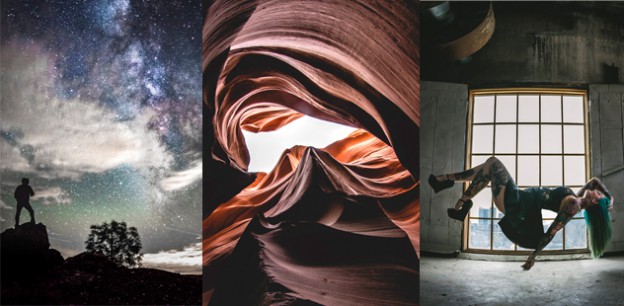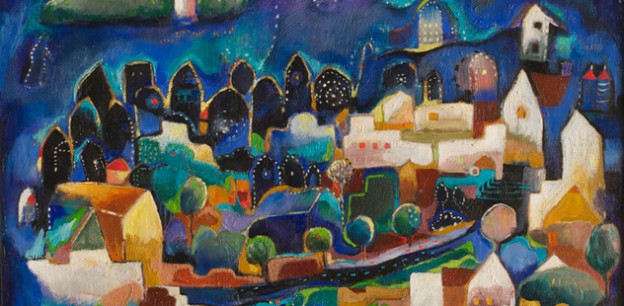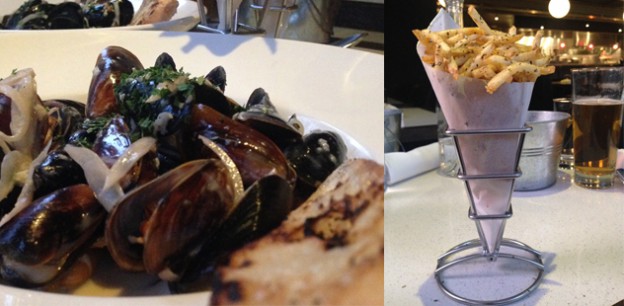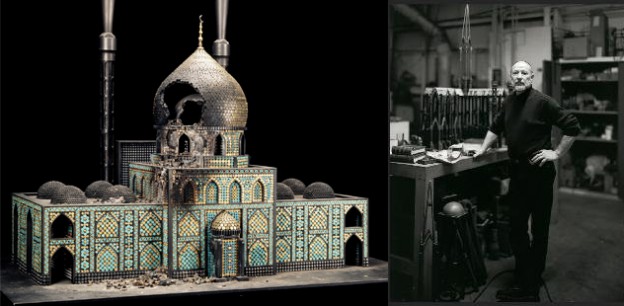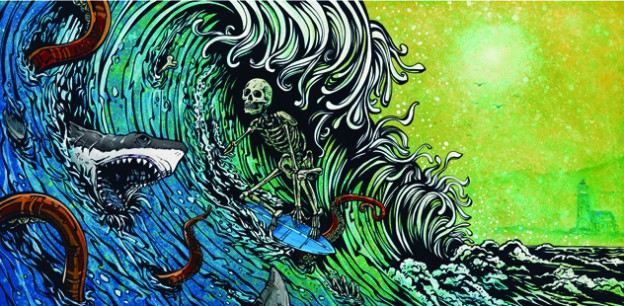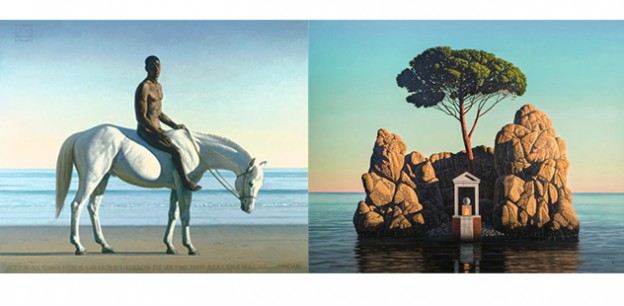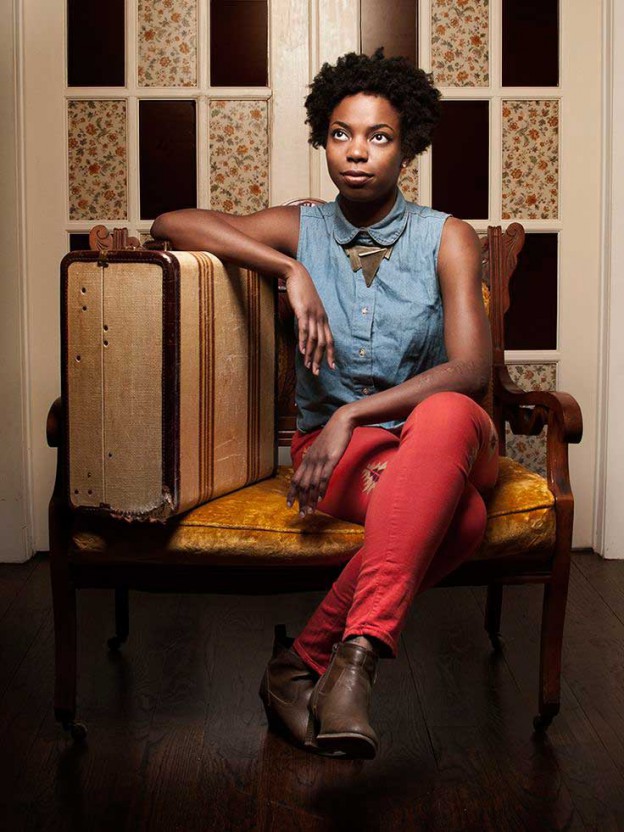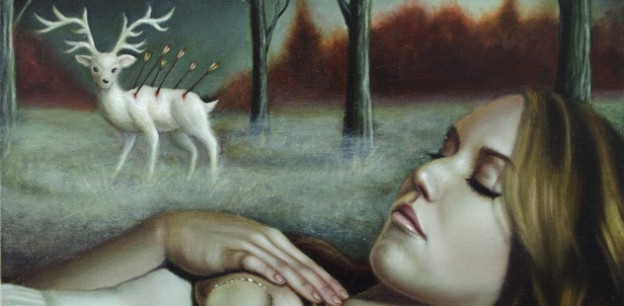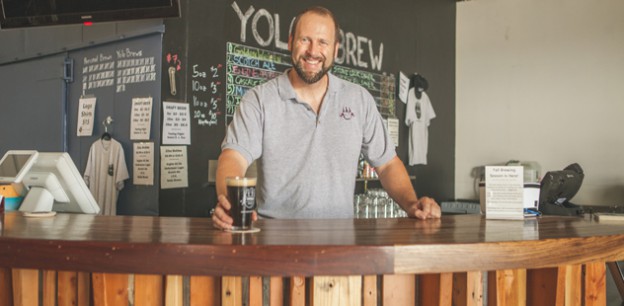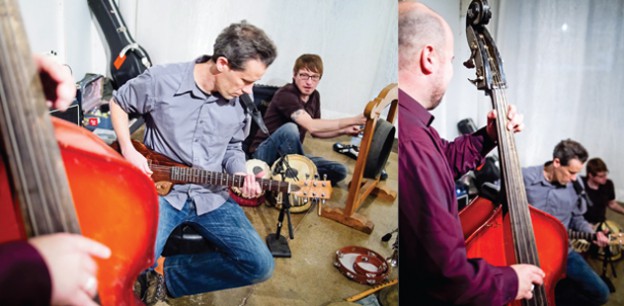Shutter Superman
Days before Thanksgiving, Felipe Silva and a few close friends woke up and started a photography road trip that would span more than 3,000 miles through four states.
In the first two days, the crew got lost in the sand dunes of Death Valley, stood above Zion National Park in Utah and Horseshoe Bend in Arizona, then headed back to Utah to Canyonlands National Park and Arches National Park, where they caught a sunrise and their first day of sleep. The last leg started with a drive up to Salt Lake City, then west to Lake Tahoe on the way home.
The five days were life changing for Silva, he says.
For a newly minted photographer still learning his craft, the trip’s sites, surprises and people all made a massive impact. These were heavily frequented and photographed destinations, but Silva has always had a knack for being impactful, for standing up against challenges and for being highly competitive.
A scroll through the photos on Silva’s Instagram page—his only means of photo sharing at the moment—reveals a young man who loves looking over the edge of tall towers and steep cliffs, standing a few steps behind an equally brave and curious son and continuously giving back to a community that hasn’t always returned the favor.
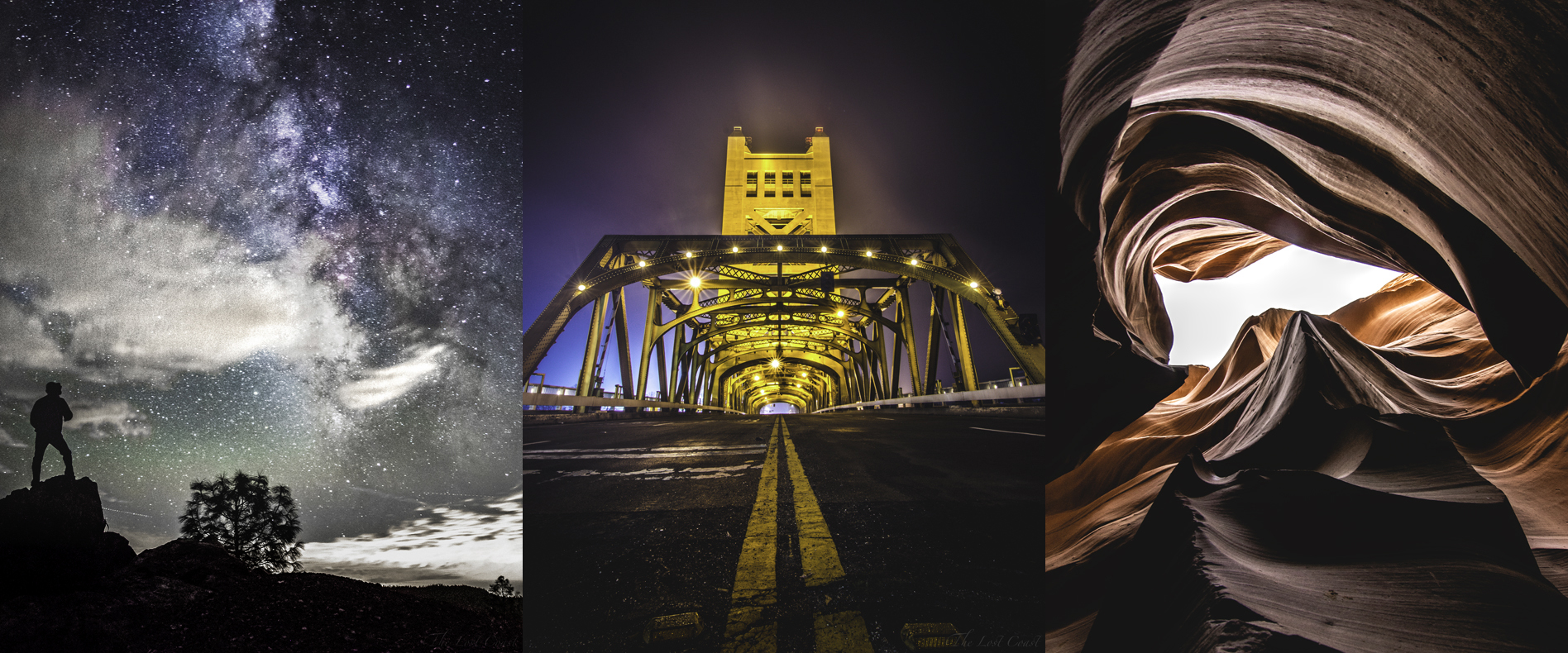
Silva moved to Sacramento from Brazil 15 years ago, when he was 13. By the time he was 17, he had been repeatedly expelled and had dropped out of high school. His mother did her best, he says, but he admits he was the one that screwed up. At 18, he became homeless. That’s when he decided he had to finish school.
“I went to a charter school and I started helping kids that were younger than me,” Silva says about the experience. “They said I was a good teacher, that I had patience. I even coached football. That’s when I decided to be a teacher.”
Silva graduated and began attending Sacramento State. In 2014, when he was preparing to graduate from college, he made a total of $8,000 the whole year.
“I always joke to this day I should have been sponsored by Top Ramen because I ate that so much,” he laughs.
While in college, Silva would run long distance, especially at night when he had time. He would sometimes run by an interesting place or a view along a freeway, but only had his cellphone to take photos.
One day, he decided to return his Beats By Dre headphones and exchange them for a real camera. He bought a Nikon, and so began his new journey.
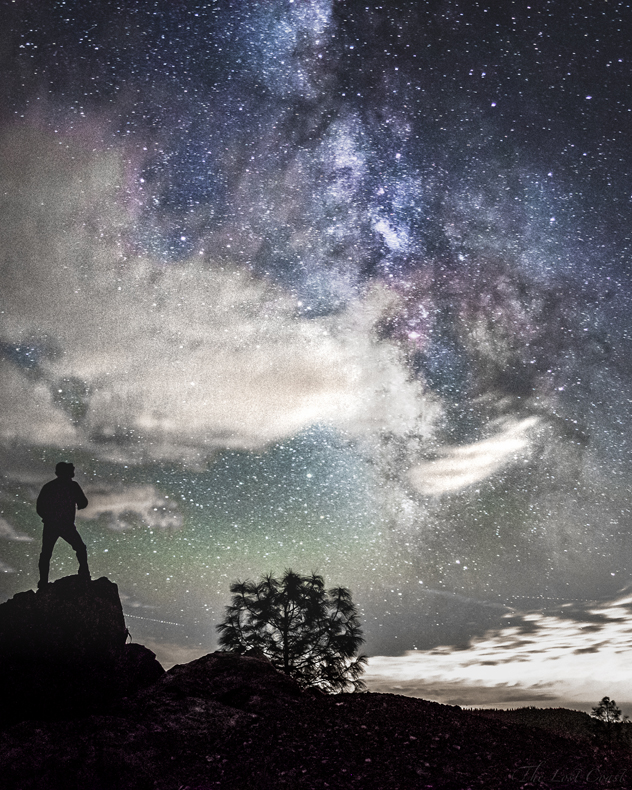
“I’d be running and tell myself I need to come back and get a photo,” he says. “I like landscapes because I like the ability of being able to sit there and observe. I like sitting on top of a freeway and seeing the people driving by. Embrace the moment and observe city life. My love is definitely landscape and nighttime, because I think it’s more difficult to shoot.”
Scroll through Silva’s photos at a slower pace, stop to read the captions, and you’ll notice the subtle changes over time in his photography as you move closer to present day. The editing lessens, the photos get crisper and the night scenes become more intricate and colorful.
The caption on a photo Silva took last year of the San Francisco-Oakland Bay Bridge captures his personality and interest perfectly: “I remember when I first got Instagram, like almost three years ago, I followed this great photographer who’d title his images simply ‘f/16 30 sec. ISO-160 52mm.’ For the longest time I had no idea what that meant. However as I got into photography I would always go back to his pictures and see what the settings were, so I can try to do the same. Jay doesn’t have an active Instagram anymore but he helped me out a lot. So I try to do the same and post the settings in every picture. I don’t always remember but I do my best. It’s all about helping others get better.”
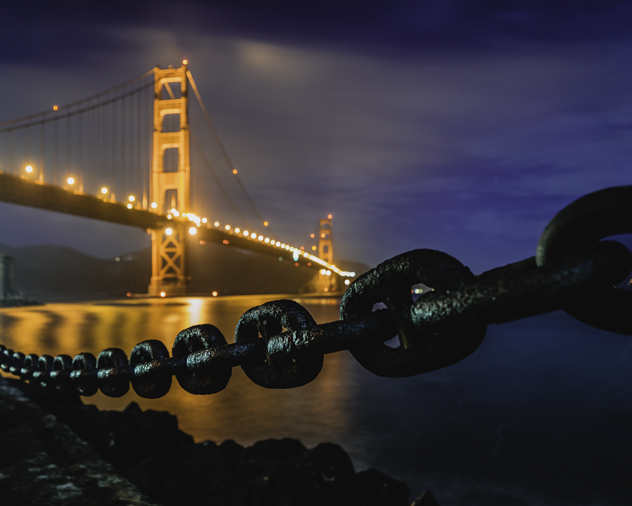
Silva has only been shooting for a year and eight months, but he’s immersed himself in a newfound love and can no longer imagine his life without it.
In true photographer form, any chance he gets, Silva grabs a weekend here or a school break there to drive across photogenic landscapes around the West Coast. It’s partly to continue to build his skill, but more to showcase through Instagram all that his world has to offer. Silva even created a collaborative Instagram page, West Coast Exposures, to help other photographers get themselves and their geographical subject matter on the map.
“When I started it, a long-exposures landscape page didn’t really exist,” Silva says. “My goal was that common people would see a picture and say ‘I wanna go there.’ That’s what I wanted people to do. And today I see it happening. The page just hit a year and we have 27,000 followers. We get 300 hits a day.”
When he’s not managing social media or taking on freelance photo assignments from the Sacramento Kings, wedding couples or local businesses, Silva is teaching fourth graders in Oak Park how to code.
Silva doesn’t have a formal education in coding, but has been tasked with teaching technology to grades K–5. On the side, he’s helping with the annual yearbook.
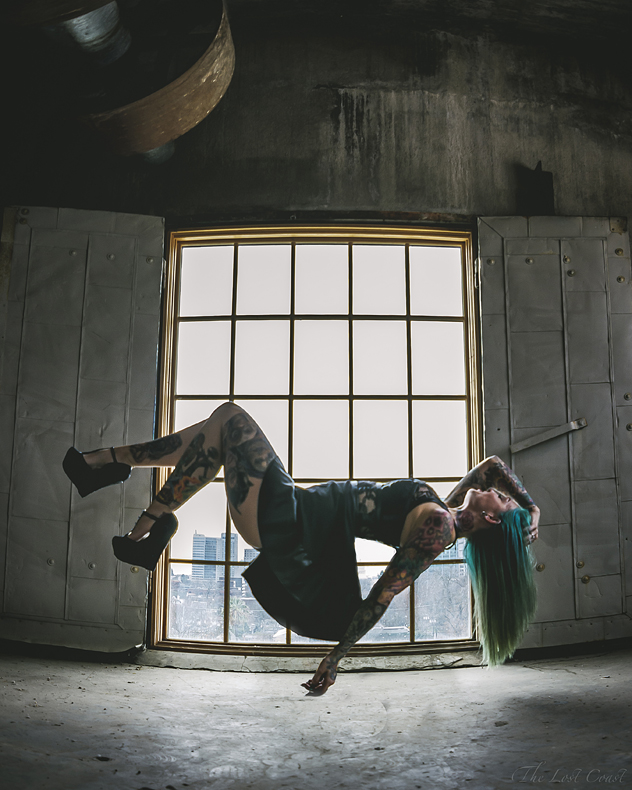
“If it was my way, I would just do landscape photography,” he says. “But I’m naturally a teacher, so I might teach photography.”
That’s not to say Silva doesn’t love helping his students today. In fact, he sees them the way he was himself at their age.
“I want to help kids who are in my shoes,” he says. “There aren’t many male Latino teachers out there. I didn’t have someone telling me I can go to college. Our school emphasizes college on a daily basis. Everything we do is toward directing them to college.”
Another way Silva wants to help is by raising money for public schools that are cutting, or have cut, arts programs. Over the years, photography classes and the like have become more rare in the public school system, so Silva and his friends are working on a concept called the Uprise Collective that would do fundraising by selling art, and also provide lessons in basic photography and editing for students interested in the subject who don’t have access to classes.
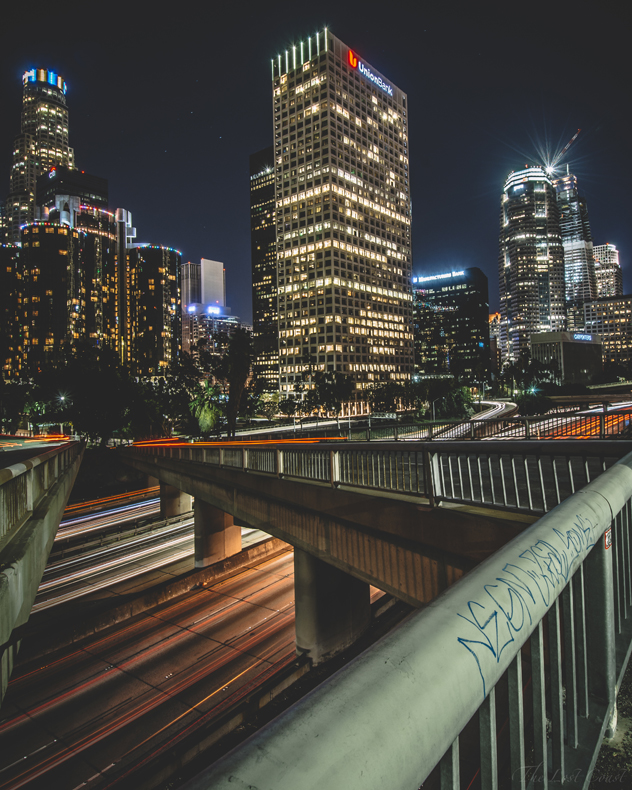
“I like to give back—I did a toy drive recently, and my son and I, on Thanksgiving, we gave out food on B Street to the homeless,” Silva says. “I was a little scared at first, but I had my son with me and it was a good experience for us.”
On Christmas morning, Silva and a friend gave out necessities to the homeless downtown, such as toothbrushes, socks, ponchos, hand warmers and face wipes. Having experienced homelessness, Silva says he knows the struggles in the winter and during the holidays can be especially trying.
The same goes for art education. Silva says he’s been lucky to be able to learn by following others’ examples. He spends at least an hour a week watching videos on how to try new photography tricks in different software programs or on his camera. He feels children should have that same opportunity.
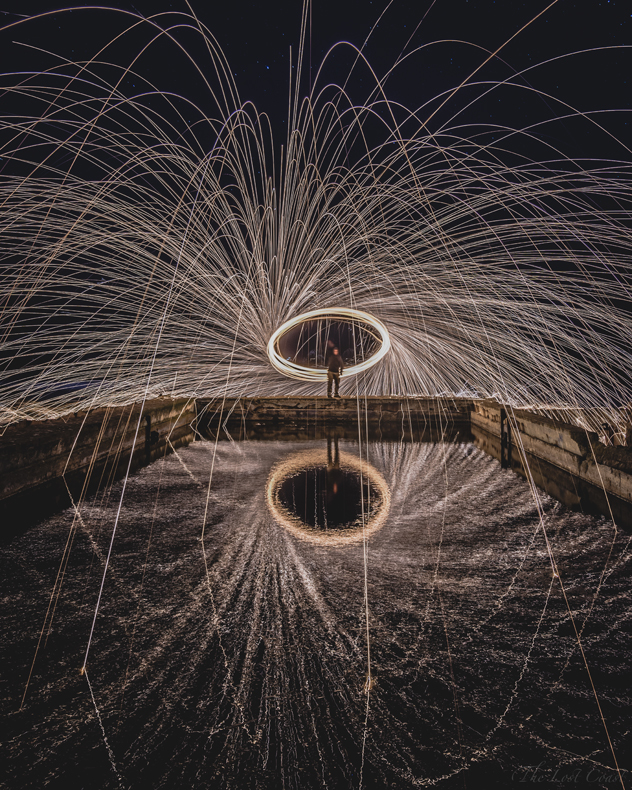
The Uprise Collective’s first event will be held Feb. 25 at Blue Lamp. The event will include original photography for sale, nearly all Sacramento-based and inspired. The photographers will also be raffling off free editing classes. This time around, all proceeds will be donated to Shriners Hospitals for Children.
“We don’t see a lot of art like ours on the wall,” Silva says about the photography being shown at the event. “There is definitely a lot of great stuff on the walls in Sacramento but what we shoot is not common. It’s not your everyday piece of art. We want to expose ourselves as far as that goes. We want to show that side of Sacramento. Nighttime, nightlife. And we want to teach people how to shoot at night. It’s a movement. That’s the only word I can think of.”
See Felipe Silva’s photography, along with the work of other great Sacramento photographers, at the Uprise Collective photography exhibit Feb. 25, 2016 at the Blue Lamp, located at 1400 Alhambra Boulevard, Sacramento. The event is free and starts at 7 p.m. with proceeds benefiting the Shriners Hospital for Children. Follow Felipe on Instagram: @The_Lost_Coast.
Nightmares and Dreamscapes
Artist Sayako Dairiki would be a therapist’s easiest patient to dissect. She paints her dreams, which she describes as a mix of her environment and her internal struggle, fueled by experiences from her current life, and possibly a past one.
One of her recent pieces, part of her Inner Landscapes exhibition at Pence Gallery in Davis, depicts a dream in which she sees a town floating at twilight, and she hears a voice say, “That’s the place your souls live.” Silhouettes of arches and points huddle close together against a ghostly bright blue background, almost like a traveler looking upon a lit graveyard.
“When I woke up I did a watercolor quickly to remember, and then did the painting,” Dairiki says of her process for the piece, entitled Town Souls Live.
Dairiki’s themes, colors and subjects hark back to medieval European art, says Pence Gallery director Natalie Nelson in her informational piece about the new exhibit. Nelson says Dairiki’s use of brilliant indigo hues and gold leaf, and her paintings of angels, saints, keyholes and archways, are reminiscent of a hidden, ancient realm.
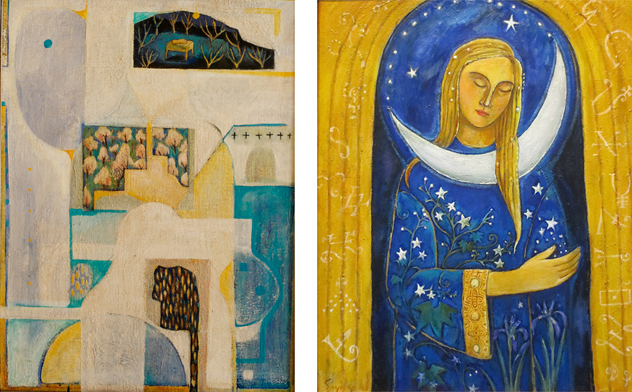
{Memory from Winter to Spring | Oil on linen. 18″ x 24″ /// Spirits: Night in May, California | Oil on linen. 16″ x 20″}
Dairiki says she has only a few explanations for her affinity toward medieval subjects. One reason could be her exploratory trips to Italy with her husband, and the icon paintings in Christianity that always leave an impression. An example is her piece, Night in May, of a robed young woman with straw-colored hair nodding on a crescent moon. The wildflowers on her robes exemplify the rural, natural environment where Dairiki spends most of her time.
Another explanation is her love for the writer Herman Hesse, and particularly the influence of his books The Glass Bead Game and Narcissus and Goldmund, which include medieval, spiritual and self-realization themes.
“They’re not directly following the story but you know when you read a book, you get an image in your mind,” she says. “I try to put those images into my paintings.”
Finally, a third source of inspiration Dairiki calls more fairytale, but has no reason not to believe. She asked a friend, a known psychic, why she has such an interest in medieval subjects, in art and in dream.
“She said I have a past life as a nun in 13th century Northern Italy,” Dairiki says. “That kind of thing is sort of fun to say.”
Not all of Dairiki’s dreams materialize into paintings quickly. She’s still trying to get one on paper that’s been recurring for years, she says.
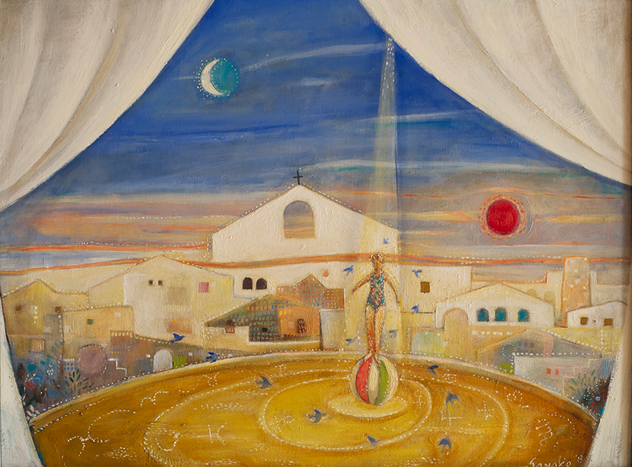
{Circus | Oil on linen, 18″ x 24″}
“It’s kind of like aged food, like cheese or wine or whiskey; you have to wait,” she says. “You have to let it sit to let it come out. I do kind of the same thing once in a while. Just don’t rush. Let it sit.”
Patience runs deep in Dairiki. She describes moving to her home in Winters as a struggle at first, after having spent the first 40 years of her life in Fukuoka, Japan; New York City; Los Angeles; and San Francisco.
“It took a while for me to appreciate this isolated beauty,” she says of her home in Winters, a sprawling 40 acres of trees, hills and animals. “I grew up in a big city and never was in the rural countryside. Gradually after 10 years I started really deeply appreciating the beauty of nature. It didn’t happen instantly. Now I like to be here. I took root, like a tree. I am a transplanted tree with roots.”
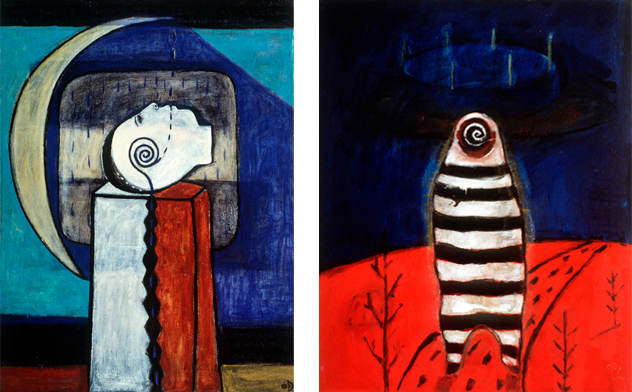
{Moon Drops | Oil on linen, 30″ x 40″ /// Shadow Field | Oil on canvas, 16″ x 20″}
The permanent move to the United States was unintentional, Dairiki says, but when she met the man who later became her husband, she decided to stay, and eventually moved to Winters to live with him and her stepdaughter.
Dairiki spends most of her day at home while her husband, an architect with whom she occasionally does projects like public art, is in town.
“So, I need to deal with my environment,” she says. “When your life is in a difficult place for many reasons, you have to deal with it right? My painting is a really good tool for me to deal with those life issues.”
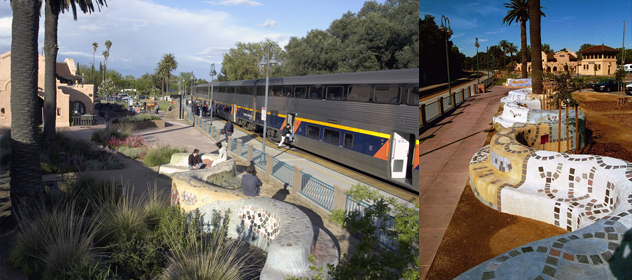
{Amtrak Depot Seating, Davis}
For Dairiki, those issues over the years have included “living in a different culture, living in a new environment or having a new family.”
“I raised my stepdaughter, for example. Now she is 24 and is fine but when she was a teenager it wasn’t that easy,” Dairiki laughs. “Painting is a really great tool to see myself, to detach and see what’s really going on. The process of painting—mixing paints, grabbing brushes—is very healing for me. It helps me face difficulties visually. Sometimes you have nightmares, but expressing those things and having deep commitment to my painting was great for my life.”
Prior to her permanent move, Dairiki had come to the United States in the late 1970s, around age 20, as a struggling artist with her struggling photographer boyfriend, both trying to make it in Los Angeles and New York.
“He did really cool photography but it was just two young people trying to be artists, and it was tough,” she recalls. “I had a lot of dreams and it was good, but we stayed less than two years.”
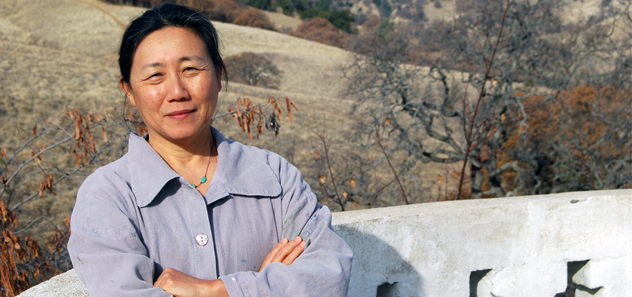
Dairiki came back to the United States from Japan in 1994, hoping to see more of the country. She moved to San Francisco and worked at a ceramics studio in Haight Ashbury, and was inspired by her new city surroundings.
Her art, she says, changes given what’s going on in her life and where she is, but it stays the same in the sense that it is always what she dreams in that time and space.
“When I was in San Francisco I was not doing rural or nature,” she notes. “It’s a big city with interesting people and so my art was different. But I always painted the dream world, even [when I lived] in Japan.”
Lately, she is trying more abstract painting, taking her dreams to another level. But, she adds, her real life still offers plenty of inspiration.
One of the most romantic, touching pieces of the Pence exhibit is Moon Night Walk. I had to ask—was that real or dream? Who is in the painting?
“My husband and I take a walk, not every night, but often after dinner, and our neighbor has a walnut orchard we walk by,” she explains shyly. “Sometimes we just enjoy the beautiful full moon and talk about the day. That’s my real experience.”
Dairiki spoke with Submerge the night her exhibit opened. She held an artist talk at Pence Gallery Jan. 17. She says she enjoys talking to people who see her work.
“Different people see things in different ways,” she says. “Sometimes people see things I don’t see in my paintings. I want to enjoy that new image in my painting too!”
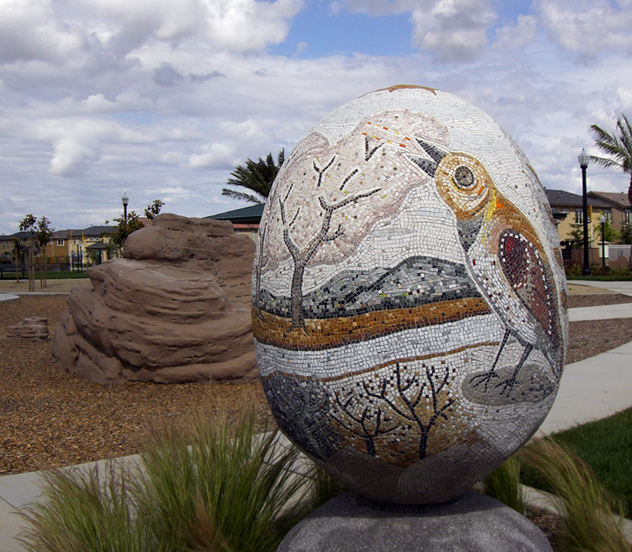
{Egg | Westhampton Park, Sacramento}
Take a glimpse into Sayako Dairiki’s dream world through her exhibition Inner Landscapes at Pence Gallery, located at 212 D Street in downtown Davis, through Feb. 27, 2016. Find out more at Pencegallery.org.
Café Plan B
1226 20th Street, Sacramento
Happy Hour is front and center on this restaurant’s website when you click Café, so it seemed an obvious choice for the Happy Hour Hound to sniff out.
The special, mussels and frites (fries) for $10 and draught Kronenbourg 1664 lager for $3 from 2:30 to 5:30 on weekdays, can’t be beat if you’re looking for a more upscale late lunch or early dinner.
Not everyone likes mussels. I asked a few friends to join and they declined, citing this very fact, and even our own Submerge editor says she isn’t daring enough to try them.
Mussel is the name for several kinds of clams that can come from both freshwater and saltwater, and the texture is usually what gets people. The meat of the mussel is plump and smooth on the outside with a slightly chewy bite.
Mussels are one of the most sustainable shellfish to catch, according to the Monterey Bay Aquarium’s Seafood Watch. They are also healthy (when not doused in tons of butter), easy to cook and beautiful in their colorful dark shells. In some restaurants, the chef will remove the meat from the shell depending on the dish, but in the case of Café Plan B, the traditional French and Belgian moules et frites are the highlight of the menu.
My husband and I had our first taste of this unfamiliar combination earlier this year in Bruges, and the experience in Midtown this week comes nostalgically close. The Café itself looked like it was plucked from the Bruges town square—a tent-like exterior has windows that remain open in summer and is lined inside with white-benched tables, with booths in the middle of the room. The black and white tables dotted with red candles are placed just far enough from each other to allow for intimate conversation, and the friendly staff gives you space to slurp your creamy mussel broth in peace.
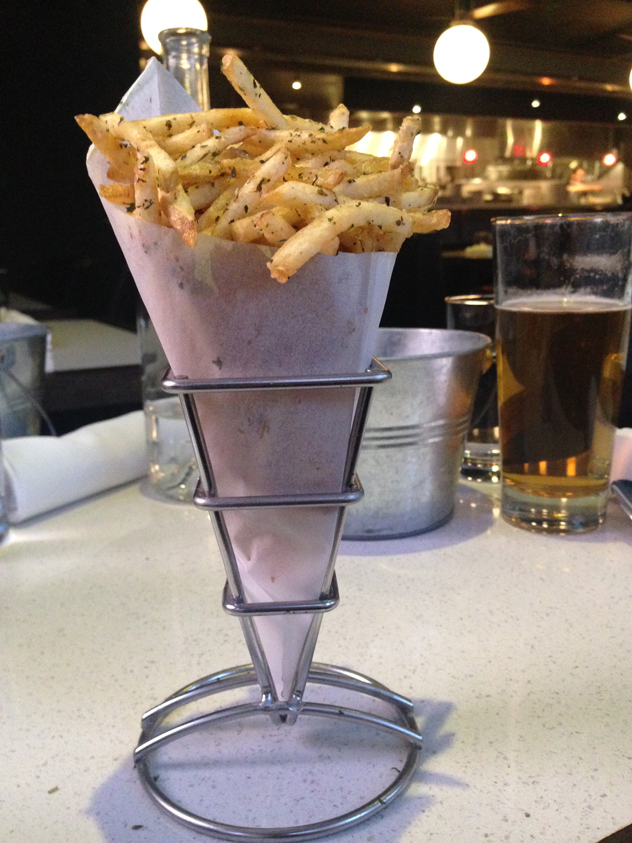
On this particular late afternoon, we also had the entire café to ourselves for more than an hour. I wasn’t sure if this was a sign that people just don’t know about this place yet, since it’s been open just under two years, or if 4:30 was a little early for the happy hour crowd. The reason could also be that happy hour in Midtown sometimes conjures up images of bar stools and televisions, but Café Plan B has neither.
To keep my bill around $20, I chose the popular mussels with nantaise broth (normally $13.95) that is made with butter, shallots, white wine and crème fraiche; a pint of 1664 and crème brulee for dessert ($7.95). Sounds like Christmas came early, huh?
The skinny cut fries came out first and were seasoned with herbs that elevated them from the usual shoestring. I ordered a side of aioli (I never saw ketchup with fries in Belgium but did see mayo, and the same is true for the café), which was equally herbal and delicious. Our waiter wouldn’t tell us the secret ingredients to the aioli, but let’s just say I have a new idea for what to do with those leftover Thanksgiving herbs in the fridge.
The mussels came out in a wide, deep dish beautifully presented, accompanied by toasted baguette slices. If you want to impress a date, but don’t want to spend more than $50, this meal will do it.
My husband, on his non-Hound tab, ordered the poulette broth for his mussels, and I actually liked it better than the nantaise, which seems to be getting all the attention on Yelp. The diced pancetta and thyme in a rich cream had that savory umami that keeps you eating even after you’re full, whereas my broth was sweet with a milky tartness from the crème fraiche.
After throwing the last of my mussels in the tin bucket provided for shells, and sopping up broth with my baguette and fries, I didn’t think I’d have room for dessert. Unfortunately, if you have crème brulee on the menu, I will order it.
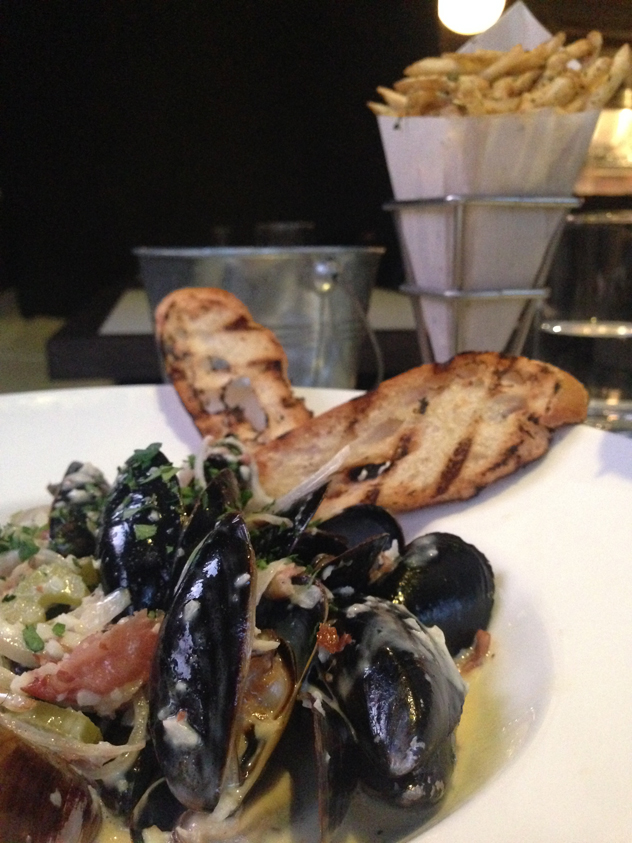
The crème was simple but perfect—vanilla bean peppered the entire fluffy custard and the fired sugar top sat thick, like an ice skating rink, my husband noted.
Now, before you dismiss Café Plan B because of its mussel happy hour, take a look at the rest of the menu. It’s not part of the special, but several appetizers and sides are under $20. I know I’ll be going back soon to try the venison carpaccio ($12.95), the pancetta-wrapped prawns ($6.95), the homemade ravioli ($10.95) and the French onion soup. They also have bottles of one of my favorite beers, Gavroche, along with a unique and varied wine list.
Plan B, the original restaurant, is even more upscale in looks and has a larger menu. It’s located in the Arden Town Center but doesn’t include the happy hour.
You could easily spend too much at either location, but I didn’t find it difficult to keep the tab low for a fine French dining experience. Just keep in mind this is a heavy meal, so don’t plan on going back to work afterward.
Weapons of Mass Instruction
Due to the subject matter of this story, during my research I couldn’t help but Google places that have recently endured mass violence.
After three obvious locations—Douma, Syria (at least 250 reported killed Nov. 4); Beirut (43 reported killed Nov. 12); and Paris (129 reported killed Nov. 13)—I nearly stopped.
I also checked local news, though nothing at such scale happened on this particular day. The daily violence involving weapons that did occur, as far as I could tell, was upsetting but unrelated to religious extremism.
This last factor is important in the context of my interview with artist Al Farrow, whose collection, Divine Ammunition: The Sculpture of Al Farrow, graces the Crocker Art Museum through Jan. 3, 2016.
Farrow uses guns and ammunition to create miniature cathedrals, mausoleums, mosques, reliquaries and synagogues. Colorful copper, brass and steel bullets line entrances to sacred spaces, shape domes and create buttresses and minarets in a beautiful but disturbing way. Farrow is a social commentator, and through these pieces, he expresses what he sees as the hypocrisy and dissolution of true religion.
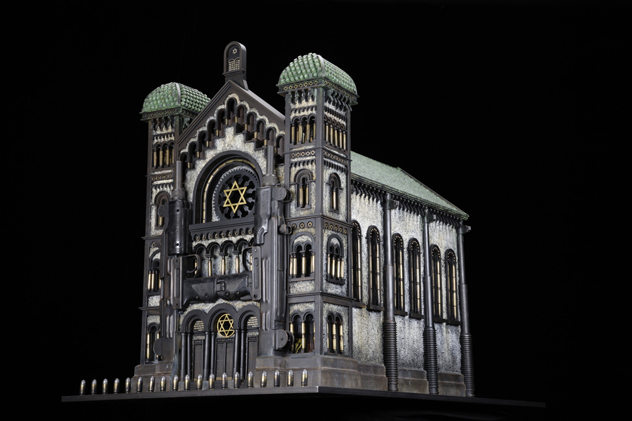
{Synagogue V | 31.5 h x 26 w x 42.5 d inches | 2012 | Guns, gun parts, steel, bullets, shell casings, lead shot, glass}
“Everyone sends out their soldiers with blessings, and says God is on their side,” he says. “They give the last rites to their dying. But they don’t prevent them from going out and killing or getting killed. Religion is not preventing what it’s supposed to.”
Farrow grew up in a secular, nonpracticing Jewish household. He says he has noticed the United States has changed from his childhood to today, but his commentary through his art since he began this body of work 15 years ago, has not changed.
“It hasn’t changed at all, since the problems that existed then are still here now, even if they may manifest in Paris instead of New York,” he says. “The idea of war and religion hasn’t shifted at all. When I was a young person, religion wasn’t playing as much of a role in American life, it was more secular.”
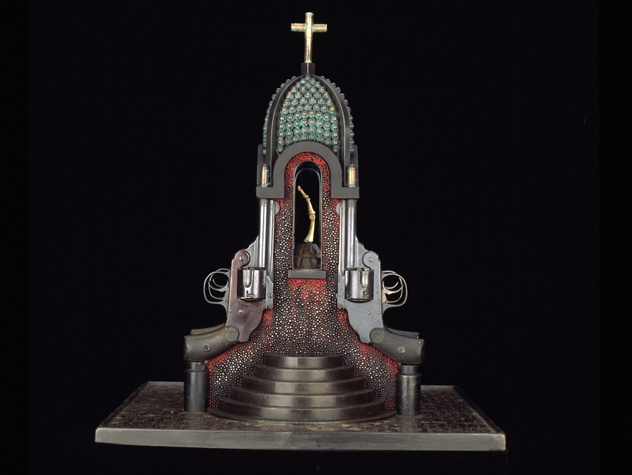
{Trigger Finger of Santo Guerro (VIII) | 19 h x 16 w x 16 d inches | 2007 | Guns gun parts, bullets, Shell casings, steel, glass, bone, crucifix}
“There has been a real expansion of fundamentalism in all major religions,” he says. “Evangelicals, Jews, Catholics, Muslims—it’s only a handful [from all religions] who are messing it up for the many.”
The 72-year-old architecture-trained artist says he doesn’t have a goal for his art, but a point of view that there “is a relationship to think about” between violence and religion.
“Would people fight over economics and kill each other?” he says. “Somehow religion goes so deep into the human psyche. My hope is that those who see my art will think about this and think, ‘I don’t have to listen to this.’ I hope I can lead them to finding those hypocrisies.”
Farrow started this body of work 15 years ago based off his first experience seeing reliquaries, some containing human bones, in the crypt of the basilica of San Lorenzo in Florence, Italy. He invented his own saint, Santo Guerro, the Saint of War, and chose bones and weaponry as the ironic materials for his social critique.
Farrow explained that “guerro” is not a real word, but a play on the word for war. He noticed in romance languages that “war” is a feminine word, so he masculinized it.
“I didn’t want to insult anyone else so I needed to make up my own saint and it had to be meaningful,” he says of the creation, whose relics lie within Farrow’s Catholic sculptures.
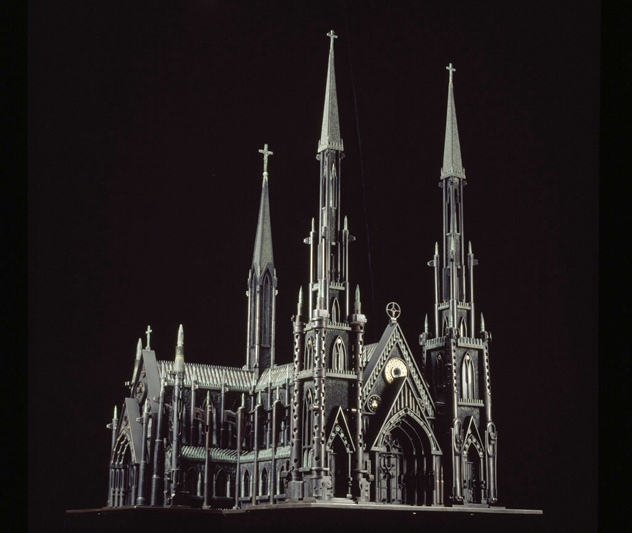
{Cathedral: The Spine and Tooth of Santo Guerro | 64 h x 50.5 w x 74 d inches | 2007 |
Bullets, guns, glass, shot, steel, bone, antique textile}
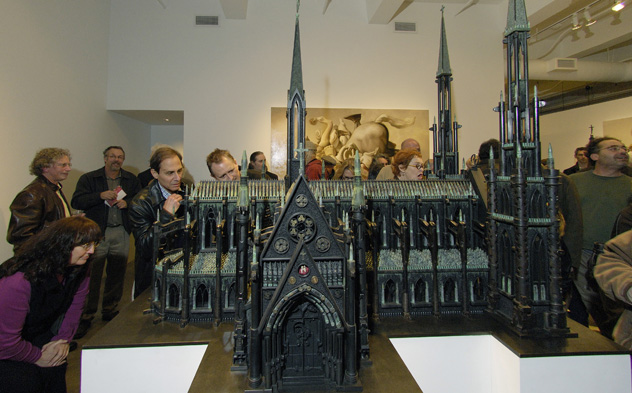
A gothic cathedral at the back of the exhibit, for example, steals the show. Known as The Spine and Tooth of Santa Guerro, Farrow used more than 200 guns and thousands of bullets to build the 1,200-pound sculpture. Its finishing touch is Santo Guerro’s gold tooth.
Farrow later evolved to include other major religions (he said he will eventually incorporate Buddhism), but because they do not have a history of relics, he found other equally meaningful objects.
Inside his synagogues he places Torah covers with the Ten Commandments, making sure the first Commandment, thou shalt not kill, is clearly visible. His synagogues always include Uzi parts, because, he says, “It’s an Israeli gun and I want to make that hypocrisy obvious.”
Farrow notes he has chosen not to place symbolic objects inside his mosque sculptures.

{Mosque III (after National Mosque of Nigeria) | 25 h x 29 w x 31 d inches | 2010 | Tank killer missiles, bullets, brass, steel, trigger}
“It’s not that I am afraid, but what I consider approaching with respect,” he says. “It’s in the eye of the beholder and I trust that.”
The changes Farrow has noticed after years of buying, dismantling and reimagining weapons of destruction, are in himself.
“Because I was not a shooter and raised around guns, it had no presence in my life,” he says of first starting out with his concept. “I was at a complete loss as a way to communicate.”
Farrow started attending gun shows and admits to having preconceived notions when first approaching.
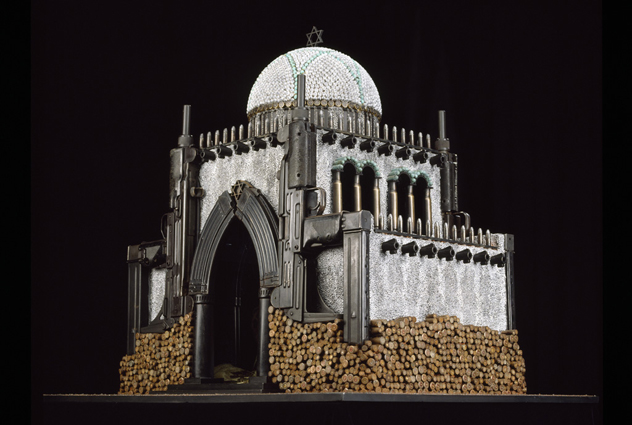
{Synagogue (I) | 32 h x 36.5 w x 27.5 d inches | 2005 | Guns, bullets, shot, steel, antique torah cover, glass}
“I am a social commentary artist and anti-war,” he says. “I entered that world with prejudices. I have learned a lot and evolved around the world of guns. I have since learned that the gun world is not just a bunch of violent yahoos. For example, there are collectors and the world of gun collecting is no different than the world of art collecting. They use the same criteria, for example—quality, rarity and prominence.”
Farrow also learned more about the culture around hunting, and the use of guns for law enforcement and protection in a business setting. Despite these more realistic uses, Farrow says he is still adamantly against civilians having assault weapons, and in his ideal world, guns would not be needed.
“I keep telling my wife, I wish they would put me out of business,” he laughs. “That would be the best thing that ever came out of this.”
For now, second best is the conversations he has been able to start through these sculptures.
“It’s intended to disturb to a degree and in that sense, it’s been successful,” he says of the collection. “It gets people into a place where they feel the need to communicate with each other. You can see masterpieces in places all over the world and people will see them in silence and just look for a few seconds.”
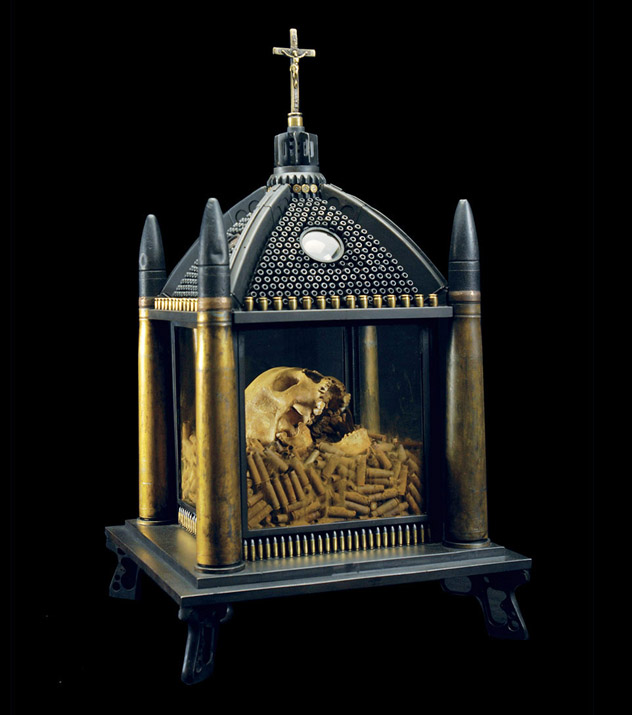
{Skull of Santo Guerro (II) | 32 h x 18 w x 18 d inches | 2011 | Artillery shells, bullets, shell casings, gun parts, steel, glass, crucifix, skull, glass lenses}
Divine Ammunition: The Sculpture of Al Farrow is on display through Jan. 3, 2016 at the Crocker Art Museum, located at 216 O Street. For more information, go to Crockerartmuseum.org. For more information on Al Farrow and to see his full Reliquaries collection, visit Alfarrow.com.
The Middle Man
Twelve years ago, a former corporate graphic designer from New Hampshire moved to California and experienced an artistic reawakening during an event that would shape the rest of his career.
David Lozeau attended the celebration of Dia de los Muertos, or the Day of the Dead, soon after moving to Southern California. He fell in love with the Mexican holiday, which dates back to the Aztecs and has become a rich part of California culture.
The Day of the Dead falls on Nov. 1 to Nov. 2 and is celebrated as a way to remember and honor loved ones who have died. Family and friends build altars to invite the souls of their departed, offering them special food, gifts and flowers. The event is celebrated with music, dance and group gatherings.
“When I first experienced the Day of the Dead, seeing the celebration each year and sharing in the community’s favorite foods and favorite songs, I was moved by the pageantry and beauty of it all,” Lozeau says. “I thought, wow, I wish I had done that when I knew someone who had died.”
The colors and liveliness juxtaposed with the ideas of mortality fit well into Lozeau’s other interests: hotrods, tattoos, lowriders, tiki culture and the Wild West.

Lozeau began using his media of choice—acrylics, gouache and one-shot enamel—to create wild character-driven paintings that told stories in a lowbrow, humorous way while honoring the purpose and nobility of Dia de los Muertos and connecting it to the rest of the world.
“The enamel is the pinstriper paint used for hotrods,” he explains. “I watched guys painting hotrods at car shows and the way they did it is how my brain works so I connected the dots. It’s a very opaque paint I can use like ink. One stroke and done. I can move fast and loose and sketchy. It gives almost that 1940s or ‘50s movie animation look—color first, then the black line goes on top.”
Lozeau, who talks fast but with precision, covers his canvases, which include traditional materials but have included reclaimed wood and surfboards, with dense acrylics to create ethereal backgrounds, then adds very intricate details like the hollowed expressions of the skeleton with the enamel.
One example of Lozeau’s cross-cultural references is his Fortuity painting on a Chinese lute called a ruan of a samurai warrior skull with a koi dragon in his teeth, “indicating good fortune is on his horizon.”
“The same way I discovered Day of the Dead as something I could relate to, I wanted to bring to other cultures,” Lozeau says. “I’m kind of the middle man.”
Being white, Lozeau says he was at first concerned when he chose to become a Day of the Dead artist, because he didn’t want to poach from a different culture. But as he learned more about it through traveling, meeting people and seeing how it matched his own ideas and beliefs, Lozeau felt he could do the tradition justice.
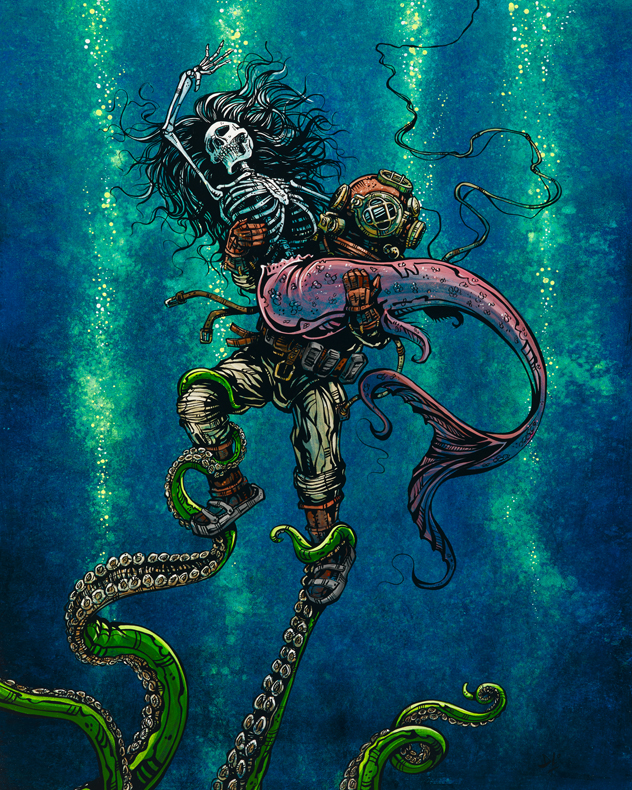
{Catch Or Release}
“I’ve been to places that celebrate death, and it’s how my house looks and how I live,” he explains when asked about what people may think about his work. “I have those grandmas you’re talking about come over with tears in their eyes for making their culture proud. They are proud that someone who is not part of it can find beauty in it. Whenever I do a live show or class, I explain this beautiful side of it, the cultural significance, and again, am that middle man.”
Lozeau adds that despite the holiday’s importance and prevalence in California, not everyone gets it and his art provides educational context as well.
He and his girlfriend have even collaborated on two children’s books based on his art that celebrate Day of the Dead through youth working together to help each other, learning to play instruments, and being themselves—even if they’re dead.
“I see more adults and older people who are confused but kids are rarely upset by skeletons,” he notes. “Even being on the road these last 12 years and the difference between the speeches I was giving then and now, the general public didn’t know what it was back then, but now with The Book of Life [animated film] and tattoos and Day of the Dead events, it’s opened it up to the general masses and it’s opened their quest to find out more.”

His efforts have paid off commercially, as Lozeau has created original work for Fender guitars, El Jimador Tequila and Disney.
Lozeau also creates custom frames for each of his original pieces.
“It’s a fun way to finish the story,” he says. “I used to do tiki carving but since I don’t do it so much anymore, the frames fill that carving void. I always say painting is the fun part, but when it’s done, it’s time for the hard part and that’s trying to figure out how to frame.”
Lozeau makes his frames nearly as elaborate as the paintings they hold, often hoarding vintage and antique pieces for years from his international travels until he finds the right use.
“If you’re looking at a painting of a giant samurai skeleton, it’s rare you’re going to say its frame is too much—that’s part of it,” he says of a frame he made to look like a Japanese temple. “And there’s no Asian skeleton samurai aisle at Michaels.”
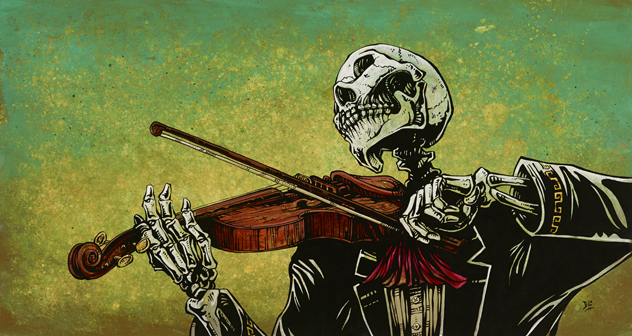
{El Violinista}
His skeletal heroes range from Wild West gunslingers and military troops, to lovers, octopi and geishas. Most recently, for the California Museum’s Day of the Dead special exhibit, John Wayne was his inspiration.
“I’m like every other boy. I wanted to be a cowboy, and I love doing cowboy action shooting where I dress up, and he’s from California,” Lozeau says of his John Wayne altar, which is up until Jan. 3, alongside with work from four other California artists who created altars for Amelia Earhart, Marilyn Monroe, Cesar Chavez and Ritchie Valens.
Celebrating Hispanic Heritage Month, the exhibit explores the Mexican cultural tradition of honoring deceased loved ones through contemporary altars paying tribute to iconic Californians.
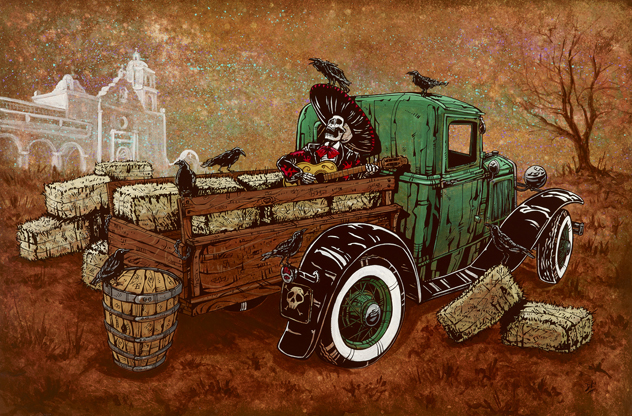
{Melody For The Mission}
This is the second Day of the Dead exhibit for the California Museum (the first one was in 2013), and was an idea from fellow artist Rob-O, who makes elaborate sugar skulls for Dia de los Muertos. The museum held a Day of the Dead party Oct. 16, and sold out of the 750 tickets available, Lozeau says. The night included Aztec dancing, food and music.
In addition to the artists’ original art and altar installations, members of the public are invited to commemorate a deceased loved one by leaving a photograph or small remembrance in the exhibit’s Community Altar through the end of the exhibit on Jan. 3, 2016.
Day of the Dead: Art of Dia de los Muertos is on display now through Jan. 3, 2016 at The California Museum, located at 1020 O Street, Sacramento. The museum is open Tuesday through Saturday, 10 a.m.–5 p.m., and Sunday, noon–5 p.m. For more information on Lozeau, or to purchase his very affordable art, visit Davidlozeau.com
California Classics
Visitors who want to get as much out of the David Ligare exhibit at the Crocker Art Museum as possible may want to approach the artist’s pieces with a notebook and possibly a Greco-Roman history book in hand.
It’s easy to float through the exhibit mesmerized by the 70-year-old Classicist’s beautiful symmetry, seascapes and elegance. His home on California’s Central Coast and his travels of the Mediterranean have inspired some of the most beautiful watercolors and oil paintings of the balance of water and land to depict life and death, chaos and calm, shadows and light, that you leave feeling serene. But that’s not all that Ligare wishes—of art lovers or of humans in general.
He sees his work as a “social project,” a push for the viewer to dig deeper into the Greco-Roman stories, landscapes, architecture and mythology from which he finds inspiration, and see how to apply this knowledge to modern life the way he offers modern narratives and twists.
Those serene images of white drapes flying above the Pacific? They are inspired by the alabaster Greek statues that have long lost their limbs and heads and of which only draped clothing remains.
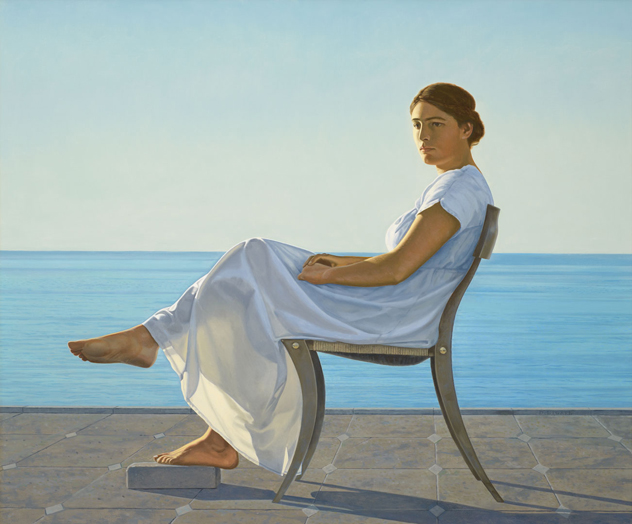
{Penelope, 1980 | oil on canvas, 40 x 48 in.}
“It is often said that art should reflect our time, but it can reflect other times, and we can learn from history,” he explains. “When I began making narrative paintings I didn’t know anything about Classicism at all. I didn’t know these stories or myths, so I just started reading. It was just wonderful to do. It was so incredible to be completely submersed in these ideas that are so rich and so surprising.”
Ligare read the great philosophers of that ancient time and was amazed with the depth of knowledge they and others discovered, whether it was being able to measure the distance to places in the solar system or setting up a democracy.
“It’s the fact that somebody like Lucretius could understand that we are made up of atoms, and we’re talking about first century B.C. there,” he exclaims. “It’s just a crazy idea somebody would have without all the microscopes and modern technology. They were measuring the distance to the moon and the circumference of the Earth. And it wasn’t just ancient Greeks and Romans but other ancient societies like the Egyptians. They were inspired to think, and maybe that’s the key right there—inspiration. Any group of people, no matter what ethnicity or location, has the potential for doing really extraordinary things. It could be fifth century Athens or 15th century Florence,” but he notes that there was leadership that inspired thinking.
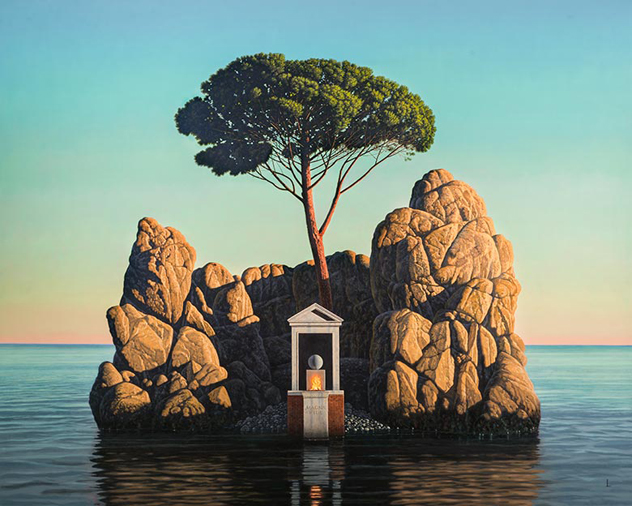
{Magna Fide, (The-Great-Belief), 2014 | oil on canvas, 60 x 80 in.}
Ligare doesn’t necessarily call himself a leader, but his belief that the central purpose of art is to inspire does then call on artists to lead in some way. He also specifically believes that the function of art and culture is to fulfill a social need, and viewers will realize that his art fulfills that need by depicting equality, the struggles of the homeless and the sick and the ideal that all things and beings can live harmoniously together.
“There’s a passion for knowledge we don’t really have right now and I would like to see that, to inspire people to want to learn, about everything,” Ligare says.
Education is how Ligare became an artist in Classicism in the first place.
“I thought it was important to begin exploring the origins of some of the ideas we were dealing with,” he says. “For instance, with homelessness, [it was important to me] to learn about what the Greeks felt about hospitality, or Romans, and what some of the underlying concepts were there and one of the concepts I’ve used most is ‘symmetria’—the idea of symmetry.”
Some of Ligare’s paintings at the exhibit depict this concept, which came from his research of Polykleitos and the harmonious integration of the disparate parts of the human body.
These paintings show the diversity of society and things in nature and how they fit together in a harmonious way.
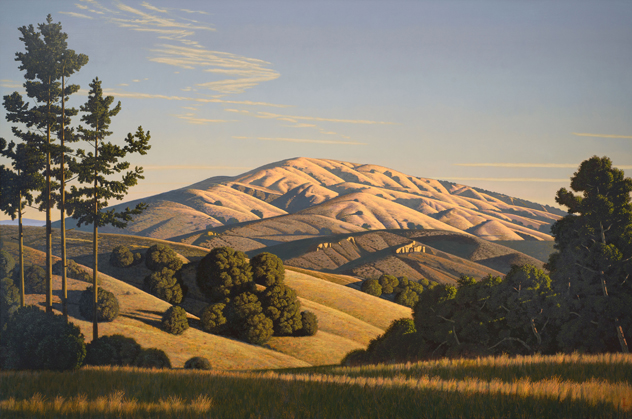
{Mountain, 2013, oil on canvas, 60 x 90 in.}
“That is such an important ideal in modern society that I think it’s important to date back historically,” he says.
To discuss modern issues that society has seen over the last few decades, Ligare painted his perfectly symmetrical Vitruvian Man black, to coax people to talk about integrated as opposed to segregated society. The male body is harmoniously in proportion to the architectural structure behind it, which is harmoniously in proportion to the environment behind that.
Ligare says his concepts sometimes become very esoteric, but that’s where the fun is for him. His massive, attention-stealing painting Arete, for example, is a naked black man on a white horse, and caused many museum visitors to pause and stare.
The layers behind the painting bring much perspective. Arete in Greek has to do with the idea of excellence of the human spirit. The quote scrawled below the horse comes from a fifth century B.C. poem written about an athletic event, and Ligare wanted that athletic excellence idea to carry over to excellence in knowledge. His reason for using a black man also has to do with the two kinds of ceramic pots used in Ancient Greece, in which earlier pots were black figure vases, and the poet he references in the painting came from that period.
“For me, all of these paintings are so wrapped up in ideas and it’s difficult to boil them down to just a few words. But in that case I wanted it to be a man who had a great amount of integrity about him and carried himself as an excellent human,” he says.
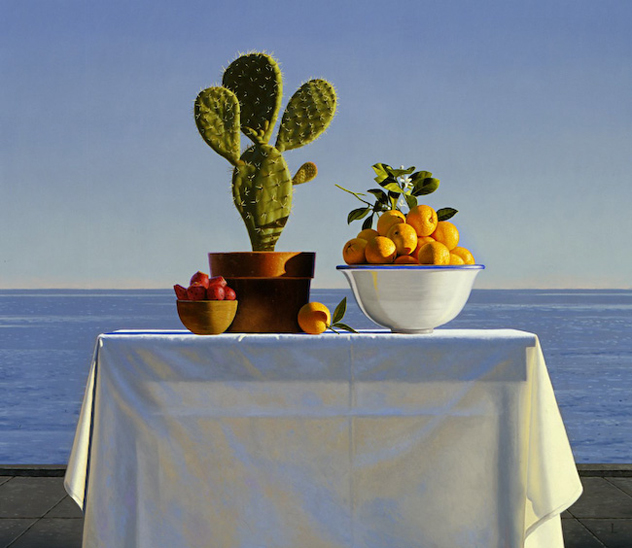
{Still Life with Cactus and Oranges, 2001 | oil on canvas, 40 x 48 in.}
Ligare’s latest pieces hang at the very beginning of the exhibit before entering the room, and focus on architecture. The artist—who used to teach drawing at architecture schools in Wales and at Notre Dame—also finds great inspiration from past and current architects, especially the New Urbanists.
“I use history to recreate a narrative into art that way they [New Urbanists] were trying to create a narrative into cities to bring back a sense of character that would make them more livable,” he says.
Ligare doesn’t limit himself within a painting to a certain time period or place, which adds yet another dimension to each piece.
“One of the things I really like doing with all this stuff is being flexible and fluid in time; being comfortable with moving from 18th century to 17th through the Renaissance to even beyond to cave paintings in the neolithic era, and not be fixed to contemporary ideas or contemporary culture,” he notes.
That fixation to what might be acceptable in a specific place or time frame is something Ligare continues to rebel. It’s almost epitomized in one of his pieces—Ligare painted a male diving into a sea to show the balance of opposing forces of order and chaos, something he says he’s put into his work for the last 35 years. The painting of the diver was influenced by a tomb in southern Italy, which he says was likely not belonging to a diver, but was a representation of a person moving from air to water and from life into death. The painting is based off a photograph of Ligare as well, diving into the Aegean Sea.
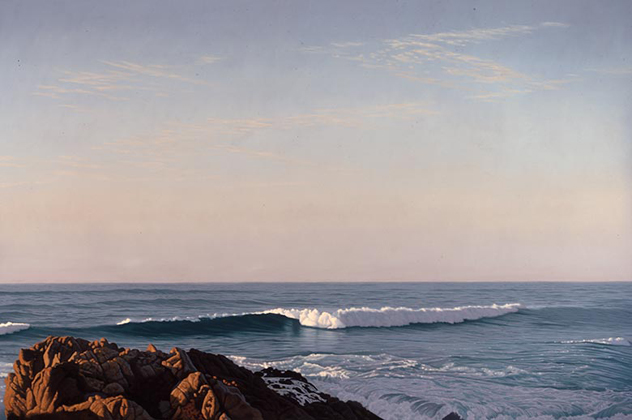
{Seascape, 2003 | oil on canvas, 60 x 90 in.}
Ligare said he couldn’t help but laugh and include a new angle to the diver story when he found out that the main painting on large billboards advertising his exhibit in Gdansk, Poland, was the nude male diver. However, when he mentioned this to the Crocker, they didn’t seem to agree with the use of the painting for public advertisement.
You can see the infamous diver and dozens of other equally intriguing, educational works from Ligare at the Crocker Art Museum through Sept. 20.
David Ligare, California Classicist is on display now through Sept. 20 at the Crocker Art museum, located at 216 O Street in Sacramento. You can find hours of operation, as well as purchase admission tickets, through Crockerartmuseum.org.
Comedy, On the Rocks
Comedian/actress Sasheer Zamata has a sketch in which she’s walking down a New York City street when a male stranger comes up to her, asks to walk her home (she says no and keeps walking). He then pulls out his junk and says “Hey Miss, this is for you!” Hilarity ensues as Zamata tries to see the interaction from the exposed man’s perspective, and even praises his polite directness.
“It was like a date with a lot of stuff missing out the middle,” says Zamata. “It was short and sweet. Everyone was honest with their feelings. It was probably the best date I’ve ever had actually.”
As hysterical as it is, the sketch addresses the more serious issue of society not openly talking about and taking proper action against sexual harassment. It’s something Zamata discussed over the phone last week while answering questions about her upcoming Sacramento stand-up show, her dream-come-true career as a Saturday Night Live cast member and coming up with new material.
“Everyone probably has some sort of uncomfortable sexual, weird moment with a guy, which sucks,” she says. “It’s shitty to think it’s just inevitable that something terrible like that will come across your path in life. I do like talking about that on and off stage so people know they’re not the only one and it’s not your fault, that it’s more common than we think.”
Zamata says she admired the Columbia University student who carried her mattress around campus after she was assaulted, forcing people to have that conversation.
“Even in my neighborhood now—I live in Brooklyn, and it’s a safe part of Brooklyn—I have gotten followed walking home and my guy friends are like, ‘No, how is that possible?’ but it doesn’t matter where you are, it’s possible,” she adds. “So if the conversation includes men more, maybe they can check each other on that like, ‘Hey man, maybe don’t be an asshole to this girl or don’t push her too hard at the party.’”
Zamata says she talks about what’s going on in the news with friends and coworkers when figuring out the best execution for serious topics.
“Some things are better as a sketch or a joke or a short film and I just write everything down and think about what I want to say, and sometimes I just get on stage and talk about it,” she says. “Lately, because a lot of the news has been intense, it’s more talk and not necessarily jokes, but I work out how I feel about the situation and people in the audience are with me, they get it.”
It’s not easy to address racial issues or tragedies, or conversations society has been avoiding, but Zamata says she sees it as a comedian’s job to shine a light on these things in society, reflect on them and be a mirror.
“That’s what I try to do and it’s been getting a good response,” she says.
If you’re getting worried Zamata’s shows on July 11, 2015, at the Comedy Spot are going to be Debbie Downers, they won’t. The improv extraordinaire has been working on new material that most fans have not yet seen, unless they’ve caught her in late-night action around NYC.
The shows are part of her first major cross-country tour, Whiskey on the Rocks. And yes, that is her drink of choice for those of you who’ll be attending or catching up with Zamata at a bar after the show.
The 29-year-old has had a whirlwind year-and-a-half after joining the cast of SNL, and has won over viewers with her on-point impressions of Michelle Obama, Rihanna and other prominent black women in society, who, for the last eight years, were mostly being played by SNL male cast members, if played at all.
“We have a lot of black people on the show who want to shake things up and want to talk about things that may be uncomfortable, but we want to talk about it so we try to put it into the most digestible package,” Zamata says. “It’s hard because we aren’t like this new punk show just starting out; we are a show with a long tradition and have to appeal to our longtime fans.”
Zamata is free to perform as she pleases in her own live shows, but has realized that since starting her new job, audience members sometimes expect to “see SNL” at her performances.
“Older people would be like, I was a fan since the 1970s and I was really hoping you would do Michelle Obama,” she laughs.
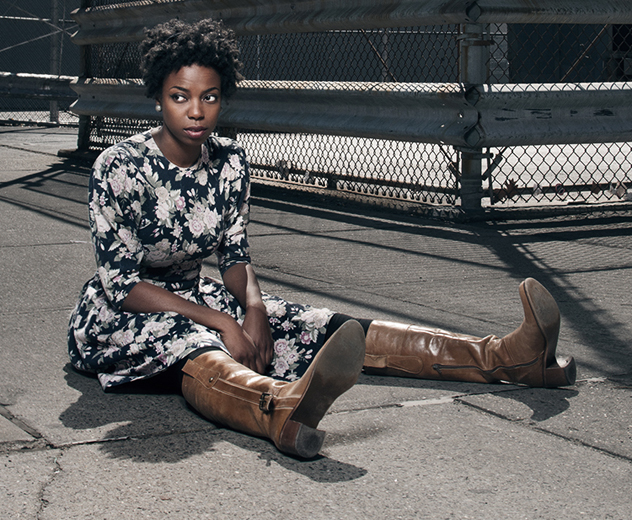
Her love of performing started at a young age, and not in improv but in show choir (she notes that ever since the SNL team found out she could sing, she has had regular singing sketches on the show). It wasn’t until middle school that a volleyball coach with a love for ComedySportz introduced Zamata to competitive short-form improv by taking the team to a show at the end of a season.
“The first time I went I thought, what is this magical thing, and I was so enamored,” Zamata says. She forced her parents to take her to more of the shows and in high school, she joined an improv team for a week before realizing it conflicted with her show choir schedule.
“So I’d just watch Whose Line Is It Anyway all the time and was still an improv fan,” she says.
After graduating from University of Virginia with a drama degree, Zamata moved to New York and joined the Upright Citizens Brigade (UCB), whose ranks include hundreds of famous comedians and improv artists like Amy Poehler, Matt Besser and Ian Roberts.
“I started doing improv because I liked improv,” Zamata says about her switch from choir and musical theater. “It was the same with sketch and stand-up. I barreled into it and figured I’d stop when it stopped being fun but it has never stopped being fun.”
When Zamata joined UCB in 2009, she was the only black female. Since then, several more have joined the group and even more women are in leading roles in comedy than Zamata ever remembers.
“I think it’s all about representation; seeing someone on stage or on screen who looks like you is a huge help,” she says. “Donald Glover was performing here [at UCB] and even though I’m not a guy, he was someone I could relate to and that was a huge help for me. It helps to have a relation to someone that you’re watching. If all you see is one kind of person, it may seem hard to get into it.”
Zamata says she noticed during UCB’s annual Del Close Marathon—a three-day improv event in NYC—that improv students of color were taking pictures of her and saying they couldn’t wait to show their friends and families that people who look like them are doing this work too.
“I feel proud that I was able to be at UCB for so long and now there are more people who look like me there,” she says, but adds that comedy, and especially improv with its expensive classes, can still be hard to reach for many young people because of socioeconomic issues or because they don’t have the exposure in their schools or towns.
“But I think it is changing and the more exposure UCB and the form has to people the more diverse it’ll become,” she says. “This is a good time for women in comedy and I feel excited to be in the mix of it.”
To get Sasheer Zamata that whiskey at Comedy Spot on July 11, go to Saccomedyspot.com/sasheer-zamata for tickets. She has two shows: 8 p.m. and 10 p.m. and tickets are only $20.
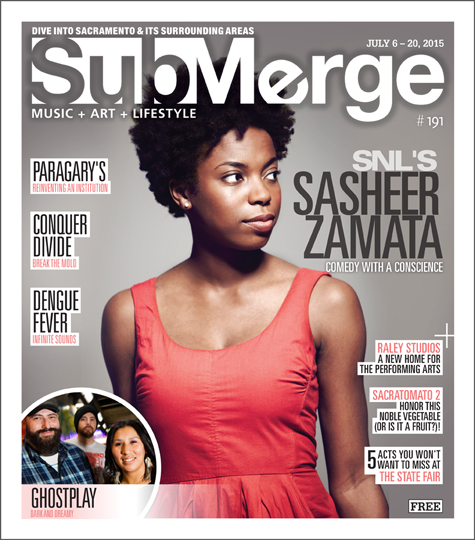
UC Davis alum Michael Ramstead finds himself in elite company in Elliott Fouts Gallery’s upcoming exhibit
UC Davis has consistently hired and/or trained some of the top American artists of the last half century.
Its proximity to the Bay Area and Greater Sacramento Area, both brimming with million-plus populations, galleries, museums, local artists and global visitors, allows the public to experience the art that has come out of this relatively small but renowned art department.
Elliott Fouts Gallery on P Street in Sacramento is taking advantage of the talent with its show An Eclectic Grouping, featuring select faculty and alumni. Among the renowned are professors emeriti and Bay Area Figurative Movement artists Roland Petersen, Manuel Neri and Wayne Thiebaud. Alumni—many of whom studied under the aforementioned—include Peter VandenBerge, whose sculptures have shown at the Crocker Museum, SFMOMA and the Smithsonian Institute; his daughter and sculptor Camille; sculptors Tony Natsoulas and Rene Martucci; and painter Vonn Sumner.
When 27-year-old Michael Ramstead received a request to join the show and round out this list, he didn’t realize he’d be the youngest of the group.
“That’s actually quite an honor, and I really appreciate the gallery reaching out to me and inviting me to show alongside these accomplished artists,” he says.
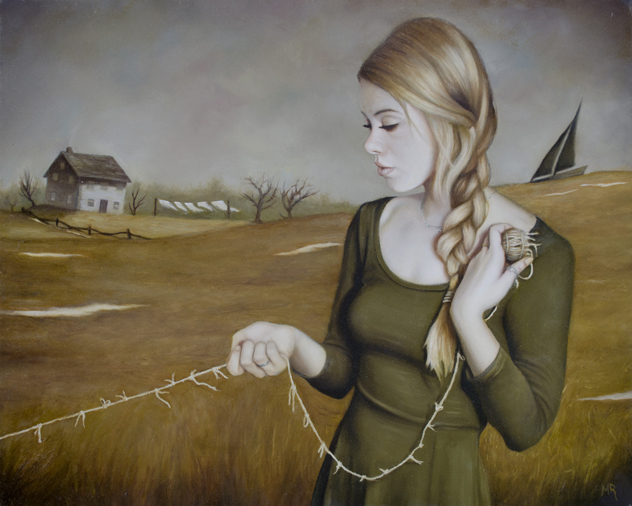
{Ariadne}
The invite isn’t really a stretch once Ramstead’s work is placed with the others. The Long Beach, California resident and 2010 graduate of the UC Davis Art Studio focuses on pop surrealism, portraiture and lowbrow illustrations that reflect his generation just as the Figurative masters reflected theirs in the ‘50s and ‘60s.
Ramstead fell in love with painting in his senior year of high school when he was exposed to more illustrative artists at that time.
“Usually you think of modern art as more interpretive and weird,” he says. “I’ve been more influenced with cartoons and video games and seeing fine artists use those as inspiration…it’s a more illustrative style than I’ve ever seen. I’m really glad this type of art has become more popular over the years.”
Some of these artists included Mark Ryden, James Jean, Alex Gross, Shaun Tan and photographers/installation artists Nicholas Kahn and Richard Selesnick.
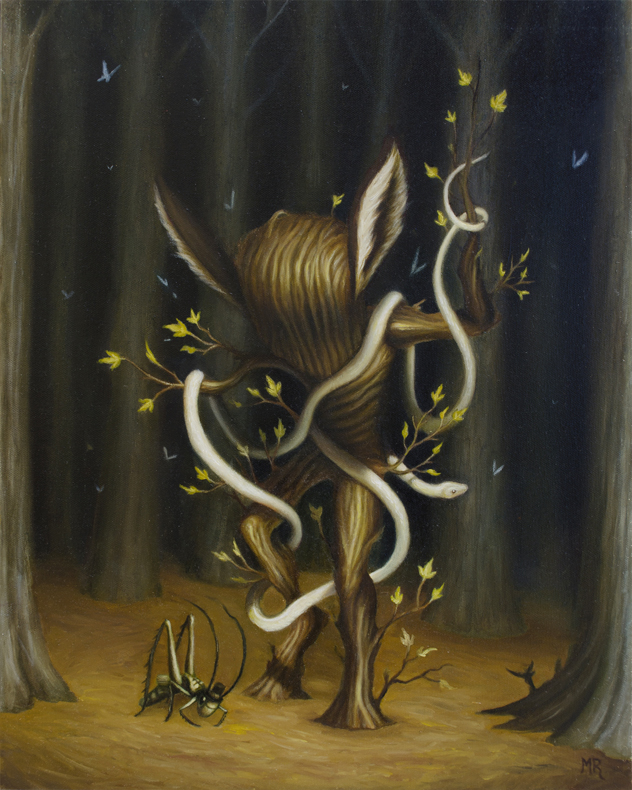
{Woodenboy and the Serpent}
Ramstead says he wants his fine art—the oil paintings—to reflect more of his skill and himself as an artist, while his illustrations are more of a quick expression of his feelings.
“I take in a lot of pop culture, movies and music and they mean a lot to me, and these illustrations are a fast way to get that out,” he says. “It’s still me, but it’s a quick way of saying, ‘hey I like this.’”
Examples of the illustrations are definitely more prominent across Ramstead’s social media, as he’s another in a quickly growing line of young artists who has embraced platforms like Instagram, Tumblr and Twitter to share and sell art.
His influences and thus his connection to his fans have become better established through these means. So basically, if you’re feverishly texting your friends about Wes Anderson, Taylor Swift, ‘90s cartoons, podcasts, manga and anything else pop culture, Ramstead is doing the same, but also expressing his thoughts about it all in intricate sketches and humorous caricatures.
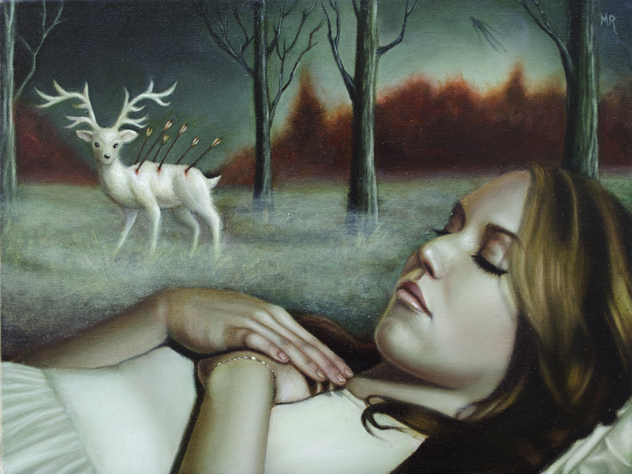
{The White Hart}
“One thing that got me into drawing was horror movies,” he explains. “I did a challenge for myself and watched a horror movie every day in the month of October and did an illustration based off of it. I became a fan of the more cartoon-y ones.”
These, and some very sweet illustrations in the same vein but with romance movies, can be found on Ramstead’s website (Michaelramstead.com) and social media pages.
“I’ve been able to connect with people like directors and singers who say they like my interpretation and it’s really cool to see that,” he says. “There are a lot of galleries right now that are focusing on pop culture art as well.”
For example, Ramstead has painted scenes from movies like True Grit and Rushmore for showings at Spoke Art Gallery in San Francisco.
His lifelike fine art also has a similar but more intricate inspiration.
“For a while the inspiration for the paintings has been different stories based on the paranormal, folklore, Greek mythology, horror movies and horror stories,” he says, which is noticeable in most of the paintings but not always in the foreground. Sometimes a portrait of a young woman looking scared or disturbed at the viewer might have a creature’s shadow or skeleton lurking in the background.
“Mythology is pulling ahead as a major influence right now. But I’m trying to put it in a specific era or time period that stylistically I’ve always been drawn to.”
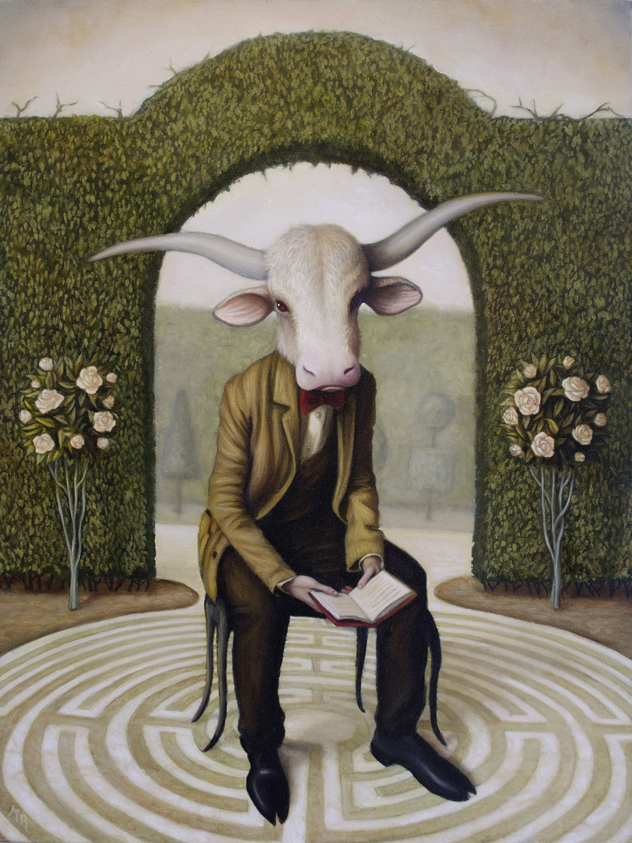
{The Minotaur}
The paintings he is referring to include Ariadne, Chione, Centaur and others, that portray women or bodies that look contemporary but match the myth in subtle scenic ways.
Many of his paintings portray women. Part of that, he says, is aesthetics—because he finds women beautiful—but the other part he thinks may be more psychological as he has always been drawn toward heroines in stories.
For the Elliott Fouts Gallery show, which runs Feb. 7 to March 5, 2015, Ramstead has three paintings: Lamplight, Phone Call and The White Hart, all of which portray women.
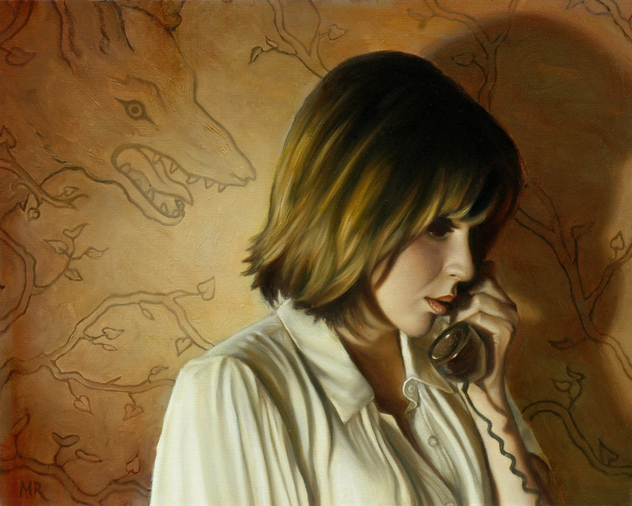
{Phone Call}
“These three paintings came out of a time when I was shifting the focus of my work from a more fantastical and cartoonish style and subject matter to more realistic portraiture,” he says. “I was consistently impressed by artists who were able to capture the human form so well and that’s the challenge I set my sights on.”
Ramstead adds that this style allowed him to hone his technical abilities. He wanted to hold on to his more fantastical elements, but also ground his figures in the real world to a certain extent.
“In these, mood is more important than any one specific narrative, though I hope there’s enough there for people to be able to create a story of their own in their minds,” he says.
Take a look for yourself starting Feb. 7 at the gallery on 1831 P Street.
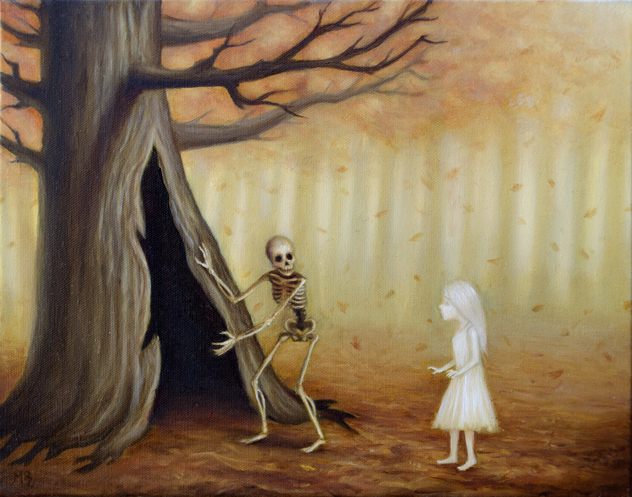
{The Way Down}
Elliott Fouts Gallery’s hours of operation are Tuesday through Friday, 11 a.m. to 6 p.m., and Saturday and Sunday, 11 a.m. to 4 p.m. The gallery is closed on Mondays. For more information on this and other exhibits, go to Efgallery.com.
Yolo Brewing Company
1520 Terminal Street • West Sacramento
A West Sacramento Saturday at Yolo Brewing Company looks slightly different, and smells slightly different, than you’d imagine for a taproom. A rolled-up warehouse door reveals long tables and stools; a lineup of human-sized kettles at one end, an L-shaped bar in a far corner; and side tables covered in packs of grains, malts and spices. The smell is of a homebrewer’s kitchen—of sweet, simmering roasty grains. This part brewpub, part personal brewery is Michael Costello’s Brew It Up reincarnate in full swing.
Costello first built Brew It Up in 1996 in Davis and was the majority owner. For seven years it thrived purely as a brewing kitchen. The location did some small-scale distribution but didn’t have any food. He then moved it to Sacramento, where it became a personal brewery and grill, complete with a 200-seat restaurant, 24 taps of Brew It Up’s own beer, 30 wine selections and a massive 60-item dinner menu.
The place wasn’t too big to fail—on the contrary, it stayed busy for eight years and pushed out thousands of batches of beers. But like much of downtown in 2011, the economic crash forced the brewery to shut down.
Since then, Costello says, a similar business model for personal brewing didn’t pop up but hundreds of people reached out and asked him what was next.
“It kept the wind under my wings to push forward,” he says. “Yolo is the outcome of that; and not just the outcome of my efforts, but a group of another dozen people who rolled up their sleeves and put their own money in to start.”
The new vision of Costello and his partners includes being a regional brewery that distributes in Northern California and being a destination where people can walk in and try small batches. And, of course, if customers want to get more involved they can create their own beers.
“It has the core elements of Brew It Up, but the vision and direction is not the same,” says Costello one early morning while setting up shop. “It’s 15 to 20 years of learning and making mistakes and doing things right and wrong.”
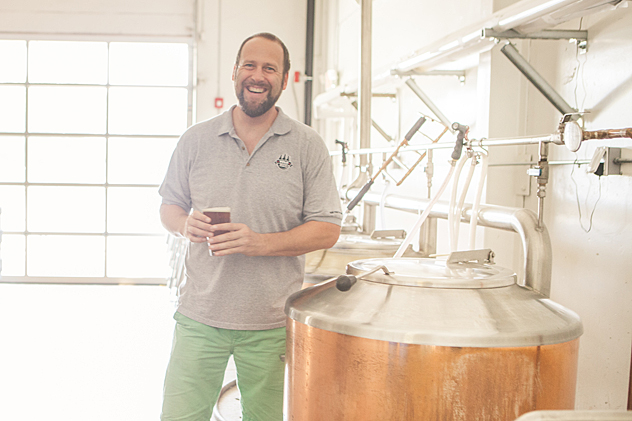
Beer lovers and their friends may schedule to brew their own batches with a Yolo brewmaster in three-hour sessions on the weekends, taking home their creation after the brewery takes care of all the dirty work (like kegging, bottling and OCD-level sanitation).
The large, open warehouse is starkly different than Brew It Up’s old Downtown Sacramento location, but the beers on tap, atmosphere and experience are just as good, if not better.
“The customers work right alongside our brewmasters, create a recipe and go through the whole brewing process, and we take care of everything else.”
Costello first came up with the personal brewery idea 15 years ago as a homebrewer and UC Davis graduate with a degree in fermentation. He was frustrated with the cumbersome process and time consumption of brewing at home with such small results.
“It was hard to perfect brewing unless I did a lot of it, so I liked the idea of having somewhere you could go with someone with experience,” he says. “Then I or a customer could go in and successfully brew a batch of beer, with relative ease and minimal discomfort, without having to do it six to 10 times a year in order for it to be good. There are homebrewers who are really good at it because they’ve practiced it so much and I don’t have anything to really offer them. But for those who only do it a few times a year, this is ideal.”
Costello notes that even though IPAs, double IPAs and sours take up most of the press in the beer geek world, customers have come in to make all styles.
“That’s a fun checkpoint for us,” he says. “When people are brewing their own beer, that’s a commitment, so it’s a demo for us of what people like and what they might want to drink in the brewery.”
When the brewmasters aren’t helping new and current homebrewers perfect a batch, they’re brewing at least 12 of Yolo’s own beers, including a Scotch ale, double IPA, orange blossom blonde and oatmeal stout.
It seems like a lot of beers for a brewery less than a year old, but Costello says the Yolo team was ready and experienced enough to do it.
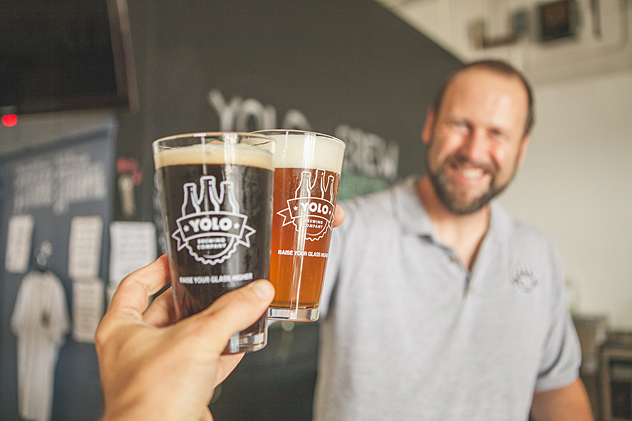
“We’re actually restrained at 12 but our tap system is set up to handle 28,” he says. “A lot of breweries that get started, especially the small breweries, for many of them it’s their first time brewing professionally, or running a business and having employees. It may also be their first time going from brewing 5- or 10-gallon batches to production size. Because I’ve been doing this for 15 years we already had the recipes down.”
That’s where the second part of Yolo’s vision comes in. Costello knows that after so long, to keep the business from going stale, it’s important to offer the customer new and different ideas. Using the small batch kettles in the brewery, he and other brewmasters are able to try more seasonal, local varieties.
“There are so many good beer recipes and so many different things you can do that are creative, especially the one-off specialty beers like SMaSH beers that use just one hop and one malt. You could do that 12 times a year and have 12 different beers,” he says.
While the Yolo team gets to experiment in-house, Costello also plans to grow one county at a time in California, brewing larger production as the brewery gains more customers and more success.
His eventual plan is to start canning in the first or second quarter of next year. Prior to that, Yolo will have 22-ounce bottles available at Nugget Markets and Total Wine in the next few weeks. Costello adds a few local pubs and restaurants are ready to take Yolo beer on tap when the brews are ready. Customers can also fill growlers on site, including the new EcoGrowler, a recycled, collapsible container that can hold 64 ounces and looks like a giant Capri Sun.
“But as we scale up, and are able to brew on large production, we can still turn to those small batch kettles,” he says. “The engine for Yolo is the small kettles.”
Here’s to at least another 15 years, and most likely more.
Check out Yolo Brewing Company Thursdays and Fridays from 3 to 9 p.m., Saturdays from 11 a.m. to 9 p.m. and Sundays from 11 a.m. to 8 p.m. Food trucks are in the lot for lunch and dinner. Yolo is located at 1520 Terminal Street in West Sacramento.
East-meets-jazz improvisational trio Swimming in Bengal releases new album
Eyes peripherally on each other, ears perked, a trio starts a meditative tune with the strumming of what sounds like a sitar but is actually Jed Brewer’s guitar, specially constructed to mimic the eastern instrument’s twang.
Brewer is accompanied by the methodical drumming of Alex Jenkins’ tabla and either a sharp interruption of saxophone or a deep rumble from a standup bass, both played by Tony Passarell, adding a jazz element to the improvisational piece.
Pieces are a more accurate description than songs for what makes up Swimming in Bengal’s Volume 1 album. Don’t expect to ever hear the three tracks played live. In total improv fashion, the trio plays whatever it feels, when it can, where it can, without notes.
“Sacramento is historically a music/jazz/improv city,” says Jenkins. “We have a deep and rich history of improv that dates back to the 1930s. You can find jazz/improv music every night of the week in Sacramento.”
Chances are, wherever you find that improv, you’ll find Jenkins or Passarell too—and less frequently but just as passionately, Brewer—as all three play in multiple bands, ensembles and jam sessions throughout the city, in churches, cafes, bars, music fests and local art galleries.
Jenkins has been playing drums for more than 25 years and tabla for 12 years. He took two long music study trips to India and attended the Ali Akbar College of Music in San Rafael, California, for five years.
He now teaches “everything drums” and has been a full-time musician since 2003 (often with Passarell) in The Alex Jenkins Trio, The Nada Brahma Music Ensemble, Ross Hammond, Inertia, The Alex Jenkins Sound Immersion and other bands, almost all part of the improv scene.
In 2005, he won a Sacramento Music Award for his work on the self-titled Daisy Spot record release, and another in 2008 for his work with the Ross Hammond Trio.
“It’s better than 90 percent of the crap out there,” Jenkins says about why he loves and plays improvisational music.
For Passarell, the love comes from his musical interests and influences. These include Carnatic jazz, a fusion of Indian Carnatic music with American jazz that both utilize improv; jazz pianist Vijay Iyer; and Steve Coleman and his concept of M-Base, an idea of creating music that relies on improv and has “a very angular and snake charm-y” sound, according to Passarell.
He named several musicians across the country who have mashed eastern sounds with modern jazz, so that’s what Passarell was hoping to do when he first came across Brewer.
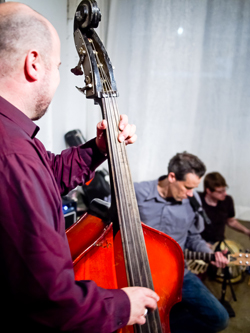
“A few years ago, my wife was teaching at a school and Jed was teaching at the same school (he teaches second grade) and we had a ton of mutual musician friends but had never met somehow,” Passarell says. “He said he had gotten this special gourd/sitar/guitar and I had heard his band San Kazakgascar that has a similar sound I was looking for. I knew Alex Jenkins for years so I introduced those guys and it was just one of those things where we got in a room and started playing together and it sounded good.”
Out of this initial session came Swimming in Bengal, for now an experimental collaboration with no specific musical direction.
“All bands are whatever the musicians bring to them stylistically,” Passarell says. “Because Alex and I are full-blown improvisers, we start at zero and end at zero. You’re using whatever chops you have and whatever you can bring to the table to hook people. It’s already a huge part of Indian music, like Ravi Shankar. He was often improvising.”
Passarell has been part of the music scene since the early ‘70s, starting with jazz but moving into early punk in the Bay Area and Northern California where he grew up.
“My first band that people actually liked was Hunting Game. We used to tour around, had a record, got some airplay, so I kind of got away from jazz in the ‘80s and then went back in late ‘80s. I never stopped listening to it, though.”
Brewer, meanwhile, grew up playing guitar and has been part of several bands in Sacramento since the early ‘90s, even starting a co-op record label, Lather Records, to release his and friends’ music. It’s a low-profile operation, he says, with no recording studio and bands paying for their releases; but with faster and easier ways of sharing music online, the bands have grown their local following easily through the small label.
Brewer’s band San Kazakgascar also has a quasi-Middle Eastern and Indian-inspired sound, something that appealed to Passarell. The differences for Brewer, however, took some time to get used to—where San Kazakgascar is loud, lyrical and structured, Swimming in Bengal is not any of those things.
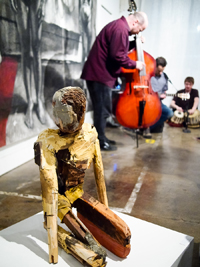
“It was challenging for me at first, but I’m getting more used to it,” he says of improvising. “We’re not doing anything authentic, just approximating those sounds and doing our take on it. [Jenkins and Passarell] come from a jazz background and I come from a more underground rock background. Sometimes we’ll do a show and I won’t have seen Alex for months and we’ll meet up and say hi and we’ll just start playing.”
Swimming in Bengal’s upcoming appearance is at the Davis Music Festival, a place dear to Brewer, as a UC Davis alum and former employee at the Davis-based community radio station KDVS.
“When I was a teenager, I really liked thrash metal so I wanted to play that and then I started finding out about other music when I went to school at Davis and worked at the radio station,” he says. “Even years after I worked there, a lot of great DJs have turned me on to music that influences what I play now. They really opened up my eyes to the weirdo music that’s out there compared to all commercial stuff.”
His favorite bands and influences include Sonic Youth, Metallica, Camper van Beethoven and Thinking Fellers Union Local 282.
As for Indian music, Brewer never grew up listening to it, but it’s always affected him.
“It’s minor sounding, and I like the chromatic nature of it too,” he says. “Something about the scales and melodies has always really attracted me. There are rock bands that have a little of that in it.”
The trance-like droning music that comes out of Brewer’s guitar suits the style perfectly, though not everyone may have an ear for it.
“We are pretty straight with the shows—sometimes we’re sitting, sometimes we’re standing,” he says. “You have to really like the music. It’s not really a show-show. You won’t see us jumping around. People with ears more geared toward instrumental like it, so it’s a small group but enthusiastic.”
Passarell separately adds that an audience hasn’t really been built for what Swimming in Bengal plays, but events like the Davis Jazz Festival have been embracing of their style.
“A lot of it is just exposing people to stuff and seeing how they react to it,” he says, adding that this is much easier to do than it was 30 years ago. “That’s a big difference between the ‘70s, ‘80s and now, being able to produce and promote your own stuff, it’s a totally different world. You could barely afford to do anything back then. It was a lot of money. That stuff’s coming around, for bad musicians and good ones. It’s kind of great though because people can decide if your stuff is good or bad.”
With the current Swimming in Bengal album out with Lather Records, and another on the way in a few months, listeners can decide for themselves whether the improvisational East meets jazz sound is right for them. Check out Sanskazakgascarsolo.bandcamp.com to order the CD or download the album. You can see the band live as part of the Davis Music Festival on June 22, 2014. The festival will feature 54 bands playing in 11 venues from June 20–22. For more info, go to Facebook.com/davismusicfest.







